 William Funkenbusch
William Funkenbusch
Home University: University of Rochester
Major: Chemical Engineering and Japanese
Current Status: Sophomore
Expected Graduation Date: May 2019
Host Lab in Japan: Toyota Technological University – Energy Materials Laboratory
Research Project: “Investigation of Pseudogap in High-Tc Cuprate Superconductors – Bi2Sr2CaCu2O8+δ” (PDF)
Why Nakatani RIES?
My parents met in Japan and it was their only shared language at the time. As a result, Japanese culture and language has always been an important part of my household. I’ve studied some Japanese culture, taken some Japanese classes, and been to Japan briefly for vacation, but I want to experience it really closely. I think Nakatani RIES gives me the opportunity to do this.
I’m also an engineer who’s caught the “research fever.” I want to try all different types of research and broaden my experiences as much as possible so I can figure out what I’m most passionate about. Nakatani RIES has a lot of cool research opportunities, and I feel privileged to be able to participate in one of them.
Goals for the Summer
I don’t want to beat a dead horse, but I think all of my goals for this summer can be put under the umbrella: “broaden my experience.” Specifically, there are three things I want to accomplish.
- First, I want to learn more about research. This is just an overall goal of mine; my current plan is professorship as a career, but one of the first steps I need to reach this is to discover what I’m most passionate about researching. To do this, I’m trying to work in a lot of different labs as deeply as possible.
- Second, I want to immerse myself in Japanese culture.
- Third, I want to step outside my comfort zone. I’ve lived in the same place basically my entire life surrounded by people who look like me and speak my language. I think going to Japan is a wonderful opportunity to explore myself and push my boundaries.
Meaning of Nakatani RIES (Post-Program)
I wrote before that the meaning of the Nakatani RIES Fellowship was for me to “broaden my experiences.” To say that now would be a gross understatement. Not only was my experience completely new to me – new culture, new research topics, new people, new opportunities – but it was at a depth that was simply unknown to me previously.
Becoming so engrossed in Japanese culture gave me an incredible appreciation for what it means to be Japanese. Comparing that to my own identity as an American made me realize that subtle differences in culture can lead to drastically different thoughts and behaviors. To stay in my American bubble and view the world according to that standard would be ignoring many relevant factors in my communication with others. In that way, this program provided me with a lot of perspective on what it truly means to be Japanese, to be American, to be an internationally conscious person.
As I’ve said, I’ve worked in research labs in the past. But, working in lab during your spare time and having it as a full time job are two separate issues. I learned much more about research – its joys and its frustrations – in this short 10 week research experience than I learned in all of my research previously. I learned what it means to be independent, and what it means to work as a part of a research team. There’s a lot of freedom in it; you can achieve things at your own pace. But at the same time, there’s a lot of pressure, because people are counting on you to get your work done and to do it well. A small, 10 second lapse in judgment can cause weeks or more of setback, which hurts not only you and your research, but others in your lab. Remembering that, and keeping yourself focused, patient, and responsible, are so important in lab.
I also got the amazing opportunity to meet people from across the world, to give presentations to distinguished people, and to present my work at a colloquium. These people and opportunities shaped me in ways I could never have imagined. They gave me new views on myself, on life, on the world around me; they imparted a kind of knowledge upon me that I could never have obtained on my own. They caused me to doubt myself, to struggle endlessly, to fail over and over again. And, out of it all, I emerged stronger and more confident than ever before.
And I think, for me, that was the crux of my experience with Nakatani RIES. The confidence I gained over the course of this experience, to do research full-time, to contribute in a meaningful way to a scientific lab, to live independently, and to do so much more, is possibly the most valuable thing I could have gotten. I am returning home with a much stronger belief in myself, a new willingness to put myself out there, because I know now I can succeed as long as I give it my all.
Research Internship Overview
Let me talk a little more about lab. It’s hard to give specifics because what I did exactly changed as my project changed, but a typical day involved showing up at lab around 9 am, and running an experiment or working at my desk until lunch. Most of the lab went to lunch together at noon. After that, I would continue to work until I was done. I left at the earliest by 7 pm.
People in my lab clearly worked hard. Everyone had a clear excitement for their research, and some would often stay late into the night to run experiments. People were always willing to help me out if I didn’t know something. But, there was always this underlying feeling that there were high expectations for me and for everyone else in lab. The reputation of the lab as a great one is a very important pride of the people working there, so I always felt like I had to do good work, especially during presentations outside of lab. My mentor and professor consistently made sure I was okay and that nothing was wrong, and that my presentations and poster were of high-quality. It was a lot of pressure, to be told that I was representing the lab when I went out and gave a talk, and my presentations got torn apart at least a couple times each, but I guess, in the end, it was a good experience for me. I ended up putting a lot more effort into my talks and writing than I normally would have, and the results were apparent. That said, I still could always find little things I could do better, which made me appreciate how much more work and experience I still need. This was a part of research I had no idea was so important and prevalent until now.
I didn’t socialize much with my lab members out of lab, honestly, and I wish I had more. That said, the majority of my hours awake were spent in lab, and, towards the end, at least, I started chatting with my lab members whenever both of us had nothing to do. It was really great learning about everyone’s pastimes, goals, and personalities. I wish I had more time to get to know them.
I talked to my mentor by far the most during my time in lab. In general, he was the one who showed me how to work equipment and perform procedures. Once I had gained independence, he would tell me the things I needed to do and expect me to complete them in a reasonable time, then check up on me periodically. It took a lot of effort from my mentor, which I am really grateful for. We would often talk about things not related to research too, though, which made the whole thing feel very relaxed. Overall, I thought it was a good relationship.
I really enjoyed this research far more than any of my experiences before. I had this great combination of support from others and independence to do things on my own. It was scary not knowing what was going to happen, but exciting to think that I could discover something. It was often boring, tedious, frustrating, and just plain annoying at times, but filled to the brim with rewarding moments as well. I think this experience has made me far more likely to enter graduate school. It was a goal of mine before, but now I think I have a much better understanding of what that goal really means, and where I fit it in.
Daily Life in Japan
Outside of lab, my daily life was not exactly glamorous. I consistently did two things on weekdays. The first was get dinner, of course. That meant heading out to the local ramen shop, curry shop, food court, or konbini, and grabbing something to eat. The second was take a walk. I made it a goal of mine to explore the area I lived, and I think I accomplished that goal. Every day, I would walk for as little as 15 minutes to as long as four hours, sometimes aimlessly, sometimes towards a specific place. I didn’t really take the subway very much to save money, which I regret not doing because there was a lot of cool stuff just a half hour train ride away. Regardless, it was great for collecting my thoughts, getting fully immersed in my surroundings, and staying at least slightly active. Because of these walks, my area became a home of mine, in a way. I had a place I went to relax and take a nap (Hill’s Walk roof, 30 minute walk away), a place to ponder deeply (river right next to Hill’s Walk), etc.. I felt like I had gotten to know the town’s personality rather than just what was where. Other typical activities included practicing piano and staying in lab so late that I die as soon as I get home.
Experiences with Japanese Culture
I think my most meaningful experiences with Japanese culture came in those times I felt like I was a part of it. Riding on the train, taking a walk along the river, becoming a regular at the curry shop, I got a real chance to immerse myself in the culture. The subtle things that Japanese people just do naturally out of respect for others became very apparent. For example, on those days when I wanted nothing but to get home and sleep, the peace and quiet of the trains became a great comfort. It made me think more about what other people might be going through. Even if they look fine, my loud conversation could just be ruining their day. It’s something I have to be really conscious about, but, in Japanese culture, that kind of thing is just natural. Japanese respect isn’t just about lowering yourself or raising others up, it’s about being aware of your surroundings, how your actions impact others in ways you may not even realize. I think this is something I, and many others, could learn a lot from.
- My favorite experience in Japan was … It’s really hard to choose my favorite experience in Japan, so I won’t.
- My first favorite experience was exploring Hakone. You can see an art museum, take a cable car to the top of a mountain, eat an authentic onsen tamago, take a dip in an onsen, see tons of nature, and even hop between the rocks in the middle of the river that runs through the town. Maybe that last one is more of a weird personal thing, but, regardless, it’s a fantastic place.
- My second favorite experience was climbing Mt. Fuji. I’m not going to lie, it’s a grueling climb, especially for people with no hiking experience, like myself. Climb with caution. But, a beautiful sunrise is waiting for you at the top, and, if you go with other Nakatani Fellows, you have nothing but the best company in the world to help you through. The stars and clouds are gorgeous up there, and you can see the whole city beneath. It’s really a once in a lifetime experience, because once you go up there once, you’ll promise to yourself that you’ll never do it again. Totally worth it, though.
- Before I left for Japan I wish I had …
- Researched a little more about my research topic. You learn a lot on the job, and I was just fine with very little preparation, but just a few keyword searches on Google Scholar or something, I feel, would have made a world of difference.
- And trust me, the last thing in the world you’ll want to do during orientation is read a solid-state physics textbook. I know classes are coming to a close and there’s a lot to be done, but find time; it doesn’t need to be much.
- While I was in Japan I wish I had …
- Interacted with my lab more. I really only became close to my lab mates during my last few weeks in lab. But they were all such great people, I really wish I had more time to get to know them. It can be tough, especially if you’re typically a quiet person, like me, and Japanese people don’t typically make the first move, but make the effort; it can make your time in lab tremendously more enjoyable.
Excerpts from William’s Weekly Reports
- Week 01: Arrival in Japan
- Week 02: Language Learning & Trip to Mt. Fuji Lakes
- Week 03: Noticing Similarities, Noticing Differences
- Week 04: First Week at Research Lab
- Week 05: Critical Incident Analysis – Life in Japan
- Week 06: Preparation for Mid-Program Meeting
- Week 07: Overview of Mid-Program Meeting & Research Host Lab Visit
- Week 08: Research in Japan vs. Research in the U.S.
- Week 09: Reflections on Japanese Language Learning
- Week 10: Interview with a Japanese Researcher
- Week 11: Critical Incident Analysis – In the Lab
- Week 12: Final Week at Research Lab
- Week 13: Final Report
- Follow-on Project
- Tips for Future Participants
Week 01: Arrival in Japan
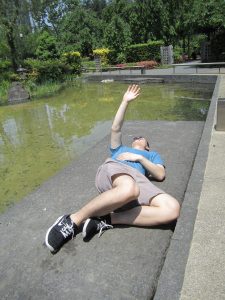
“Always do whatever’s next” -George Carlin
When I first arrived in Japan, I felt a little overwhelmed. I had hoped that studying Japanese for an entire year since last coming to Japan would help me a lot with understanding what was going on. But when I got there, the airport was filled with unknown kanji, and I felt a little scared for working in this environment for the next 13 weeks. However, this feeling faded pretty quickly as I tried to talk with people and realized my capacity has increased a lot (although not to my satisfaction).
What I’ve really grown to appreciate about Japan is how fluidly the modern, historical, and natural elements mix together. Saturday morning (5/20/17) I went to Tokyo Midtown, and walked through this park into a little pond clearing with the city skyline in the backdrop. I thought it was so beautiful, I just sat there for as long as the rest of the group would let me.
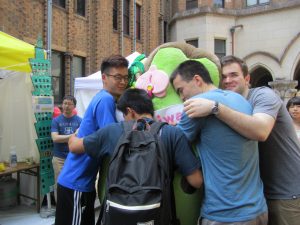
Another thing that surprised me was how clean Japan was. It’s really hard to find a scrap of trash anywhere, and there are far fewer trash cans in Japan than in the U.S.. The culture of taking care of your own trash and sorting it so well is something not seen anywhere in America.
I also really enjoy all of the free time we get. Every day we travel to a new area and try something new. And because I honestly enjoy spending time with every other person in the Nakatani group, I end up enjoying my time no matter what we’re doing (although Japan’s food, culture, and beauty are all amazing anyway). I’ve spent a surprising amount of time just wandering around looking for something (and there’s always something). On Sunday (5/21/17), for example, we tried to go to the Imperial Palace. It was closed, unfortunately, so we ended up just exploring the area, finding a nature park, museum, and even a J-Pop Rock concert. Each day seems so long and yet I don’t want any of them to end. Sorry, I’m being sappy.

Language classes are going pretty well. There are a few review vocabulary structures, which can be boring to do again, but for the most part I think it’s very informative. All of the senseis are very kind and willing to answer our questions about both Japanese language and the culture. We also have a lot of dialogue about various topics. We teach the sensei a lot about our own cultures and backgrounds, and they return the favor. It’s really cool to learn about their experiences, but also really helpful to get the chance to speak about my own; that’s what I would have to do in a real conversation anyway.
Speaking of which, what I’ve been doing extra to help propel my language further is just take every chance I get to go “ano, sumimasen,” and talk to a Japanese person on the street. Whether it’s asking for directions, the nearest restroom, or recommendations for a maid café, I always try to be the first person to say, “let’s ask someone!” Funny story. We were watching a J-Pop concert at the ToDai May Festival (super fun, would recommend), and I noticed I was sitting next to this old man. When I tried to start a conversation with him by commenting on the performance, he responded, “ah, you’re an American?” It was funny, but also a wake-up call that I’m nowhere near as good at Japanese as I want to be. I hope to improve a lot more this summer.
The seminars have been really interesting so far, especially the Ministry of Foreign Affairs. It was amazing and really humbling to think that such important people would come and talk to us about their work. I was able to discuss politics with people whose job it is to discuss politics. I felt so out of my element. At the same time though, there were science things that we knew about but they didn’t, which gave me a new appreciation for how important cooperation and communication is in the modern world. No one can do everything, and that’s an amazing thing.
Another amazing thing was the Todai (University of Tokyo) tour. Any equipment that my school has, that school had, more of and better. In addition to that, there were so many things that I had never seen nor heard of before. And the idea that anyone in Japan can gain access to that equipment and come in and use it is unbelievable to me. Back in Rochester, people in the Laser Lab (< 5 minute drive from campus) won’t let professors on campus use their equipment. The experience not only made me really excited for research in Japan, it again reminded me how important collaboration is to progress.
Nakatani has been an amazing experience for me thus far, I feel like I just need to keep doing whatever’s next.
The Pre-departure Orientation at Rice University was a great chance to meet all the fellow students. I felt like we bonded and were able to become friends really quickly. I also found the Japanese culture lessons helpful, so I knew what to expect coming to Japan and how to not be too disrespectful. I’ve been trying to do the slight head bow wherever I go, which I had no idea was a thing the previous times I went. I also would always drink and eat in the streets, just because I had no idea it wasn’t a part of the culture here. Now that I know it, I wonder how I could have ever missed it. I feel like I can act more like a Japanese person than I could before thanks to pre-orientation. Along that same vein, I felt that our Japanese culture lecture this first week was helpful in learning more about Japanese culture, specifically how to interact with Japanese strangers and people in the lab. Just say yes!
Research Project Introduction & Article Overview
I don’t really know exactly what I’m doing for my research project, to be honest. Takeuchi-sensei has told me that I will be working on characterizing copper oxide high critical temperature superconductors, but outside of that I’m not sure. He also told me that I should focus on enjoying Tokyo and not worry about studying; he will teach me everything I need to know when I get there. That said, I’m still a little nervous, so I’m attempting to understand an intro to solid state physics textbook.
Kittel, Charles. “Introduction to Solid State Physics.” 8 ed., United States of America: John Wiley & Sons, Inc., 2005
Week 02: Trip to Akita
I think I’ve settled into language classes. Recently I’ve been trying to stay much more engaged, and I think I’ve been learning a lot as a result. I definitely most enjoy speaking Japanese. I love getting time to practice my speaking skills, in class, on the street, or with the Japanese fellows. It’s a great way to get better at Japanese, but I’ve also been able to learn a lot of the nuances to the language that I never realized before. I often say something in Japanese that, if you use the literal translation from English, makes perfect sense, but is “chotto hen” (a little strange) in Japanese. It’s thanks to my Japanese language teachers that I’m able to learn these things.
So, what’s been most frustrating to me when learning Japanese is that we spend a lot of time learning specific grammar structures instead of practicing speaking. I really enjoy writing, don’t get me wrong, but my entire experience with Japanese thus far has been mostly writing based, and I want to do more speaking, because I think that’s what I need right now to improve quickly.
When I’m speaking with the Japanese fellows or other people in real conversation, I find myself often stumbling to piece together grammar structures and find the right words. I know this is only natural for someone at my level of Japanese, but it’s still frustrating because communication is so slow coming from my end. During the research internship period I want to learn to speak more fluidly, that is, with less pauses and stumbles during each sentence.
Mt. Fuji might have been the highlight of my Japan trip up to this point. We visited a lot of cool areas around the area and I got to meet the 2017 Nakatani RIES Japanese Fellows, who are all really smart, interesting, and kind people.
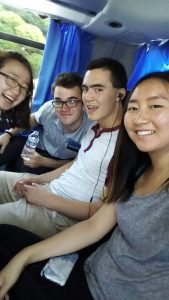
The two places that stood out to me most on the trip was the not-quite peak of Mt. Fuji (I’ll just call it “Mt. Fuji” from here on) and the onsen. I was basically asleep the entire trip up Mt. Fuji, and when I woke up my tooth was hurting from the pressure difference (apparently my nasal cavity is really close to the root of the tooth, so at high altitudes the tooth gets pushed a little). I was expecting a painful experience. But, walking around, there were so many interesting places to check out that I basically forgot about it until I got back on the bus. I got ice cream that was flavored with berries that only grow at high altitudes (it wasn’t amazing, but worth a try). The gift shop had a lot of interesting things, including this little Mt. Fuji doll that repeats whatever you say. We had a lot of fun with that.
The views were also amazing. The land around Mt. Fuji is relatively flat, and there weren’t many clouds around that day, so we got an amazing look at the landscape. There was a forest around the base of the mountain. A Japanese fellow told me that that was the suicide forest, where Japanese people would go, carrying nothing, to die. That conversation hit me really hard for some reason; I had a lot to think about as we took the bus to the hotel.
- If you’d like to read more, you may want to consult some of the following articles. Just as in the U.S., Japan has struggled to de-stigmatize mental health counseling and ensure the public is more aware of how to access support services including suicide prevention hotlines. These efforts have had success as the suicide rates in Japan have been in decline in recent years. Just as we advise in the U.S., in Japan people are being asked to reach out for help and support when needed and, if concerned about a friend or family member, to speak up and directly seek help on their behalf if needed. This is a complex problem but ultimately each and every life has value and meaning and if or when people lose sight of that our greatest hope is there will be someone there beside them to help show them the way and to stand beside and behind them so they know they are not alone.
- Suicide in Japan (Wikipedia)
- Why Does Japan Have Such a High Suicide Rate (BBC News)
- 5 Things to Know About Suicide in Japan (Tofugu)
- The Economic Toll of High Suicide Rates in Japan & South Korea (Wharton)
- Suicides in Japan Drop to a 22-year Low (Japan Today)
- Overwork Suicide in Japan (Innovations in Clinical Neuroscience)
The onsen was definitely a place that pushed me outside my comfort zone. We had to take off all our clothes and bathe in public. It was something that would be ridiculous to do in America, yet the Japanese fellows weren’t fazed by it all. “Futsuu da,” they said: it’s normal. It was something I never thought I would (and never really wanted to) become comfortable doing, but I actually thought it was a great experience. The U.S. and Japanese male fellows had a great talk in the onsen that night.
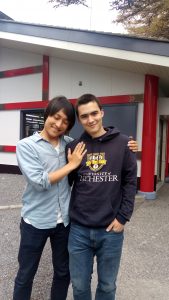
Speaking of the Japanese fellows, they were all amazing. My talks with the U.S. fellows after meeting them have largely consisted of, “I wish we were as cool as the Japanese fellows.” I had a lot of fun getting to know them, learning more about their culture, and teaching them more about ours. I really wish I had gotten to know more of them better, but I’m glad I got so much time to talk with Tomoya, Tomoyuki, and Tomo. Their names are confusing together, so I nicknamed them Tomo-cchi, Tomu-san (Tom), and Tomo-chan, respectively. Tom and Tomo-chan are actually from Nagoya and will be in the area for a little bit during the research internship. I hope to get to spend more time with them while I’m there.
The culture gap was actually really apparent between the Japanese groups and us. As an example, I mentioned the onsen. While the Japanese fellows were perfectly comfortable bathing together, they thought it was really weird that people from the U.S. hugged each other, touched each other’s hair, or even shook hands. It seems like they value their personal space a lot more than Americans (despite how packed the subway is), but, like Sarah said, doing things side-by-side is very important for their relationships. Despite this, we were still able to get along really well. I was surprised by how open they were to us, even though they just met us. I guess we’re more similar than different after all.
Side note, I keep instinctively reaching my hand out when I meet someone, which I really have to stop.
Overview of Week Two of Orientation Seminars and Activities
The lectures this week were pretty interesting. On Tuesday, Professor Kono gave a lecture about the basics of metals, semiconductors, and insulators. He also briefly dipped into quantum mechanics. It was mostly review, but there were quite a few things I had forgotten that were good to get a refresher on. Then, Professor Itoh from Keio University (Rose’s host professor) gave a talk on quantum computers. It still seems like the technology is still pretty far from being computationally useful because it’s a relatively new field, and a lot of the math went over my head, but it was really cool and the potential seems endless. He also talked about a single-atom NMR (Rose’s planned research project), which, as an NMR lover, was amazing. It seems difficult to apply, but the concept is awesome. I sense a Nobel Prize in Rose’s future.
On Thursday, Professor Kono finished his lecture from Tuesday, which was quantum mechanics from an electrical engineering point of view. There was a lot of review, but also a lot of cool stuff, and it was interesting to hear a non-chemistry side of the story. It was a good lecture, and because it was broad I felt like I had a chance to understand it if I thought enough. I would be interested in more of these kinds of lectures, but I also feel that the professor lectures are really important and thought-provoking, especially because they give us insight into what real research is like. Then, Professor Kawata from Osaka University gave a lecture about nano-bio-photonics. A lot of it went over my head, but the applications and concepts were cool.
The Friday kimono lecture was also really cool. I had no idea all of the thought that has to go into choosing your kimono. You have to be respectful to not only the people around you, but also nature. Fun fact of the day: clothing is considered an extension of the body in Japanese culture, so only single women are allowed to wear long sleeved kimono because the sleeves brush up against people.
Question of the Week
One question I have about Japanese culture is what I talked about earlier. Why is it that such a crowded place where they have people whose job it is to squeeze more people into trains has such a strong sense of personal space? I’m thinking specifically about my interactions with the Japanese fellows, who told us that aside from your significant other, it’s weird to hug someone or touch their hair.
- In part, this is likely due to the high population density in Japan. When you are always surrounded by other people in such large, densely packed villages and cities (both historically and today) it becomes even more important to honor and respect the small bits of personal space that we do have in our day-to-day lives. At the same time there are other aspects of Japanese society where Americans tend to feel that privacy or personal space (which is not just physical space in an American context) may not be respected in Japan in the same way it is in the U.S. For more on this, you may want to read some of the following articles.
I feel like I keep calling everything cool, awesome, or amazing, and that the words are losing their impact. I really mean it every time I say it, I just don’t have enough words in my dictionary to keep it varied. So apologies.
This coming week is the last week of orientation. This time next week I will be in Nagoya. It’s unreal to think about, and I’m a little scared. There’s still so much I want to do in Tokyo and it doesn’t seem like there will ever be enough time to do it. I’ve been having so much fun with all of the activities here, it’s hard to believe I’ll be working in a lab pretty soon. I’ll miss the other U.S. fellows I’ve spent so much time with these past few weeks, but I can’t wait.
Introduction to Research Topic – Questions from Prof. Kono
- What is the material you will be using/studying?
- Bi2Sr2CaCu2O8 (Bi-2212)
- Is it a metal, insulator, or semiconductor?
- Metal
- What is its characteristic dimensionality?
- I will be working with single crystals formed by the floating zone method, so the dimensionality will be 0D.
- What makes it interesting?
- Bi-2212 has a critical temperature near 100K.
- What are the properties to be studied?
- The properties to be studied are the unit cell dimensions (by X-ray diffraction), resistivity (as a function of temperature), Seebeck coefficient (as a function of temperature), magnetization (as a function of temperature), and electronic structure (by angle-resolved photoemission spectroscopy, ARPES).
- What are some possible applications?
- Superconductors may be used to create highly efficient electronic devices due to their lack of resistivity. Their ability to perfectly counter magnetic fields also allows for possible applications such as magnetic-levitation technology.
Week 03: Noticing Similarities, Noticing Differences
I forgot to put a quote in last week, so I’ll put two in this week’s report:
“A creative man is motivated by the desire to achieve, not by the desire to beat others.” -Ayn Rand
“Our greatest weakness lies in giving up. The most certain way to succeed is always to try just one more time.” -Thomas A. Edison
Japan’s subway system is really amazing. What strikes me most is how quiet it is. Even if I’m having what I think is a whispered conversation, I’m usually the loudest one in the train. If there is noise, it’s almost always a baby crying, some young kids chatting, or obvious foreigners. And that’s not just on the subway; it’s on the streets and in shops, too. The level of quietness in public areas here is something unheard of in America.
I guess in Japan this sense of public awareness and respect gets drilled into you very quickly. It might be the same reason why people don’t usually eat in public, and in general don’t touch each other (except on the really busy trains, where you just get packed).
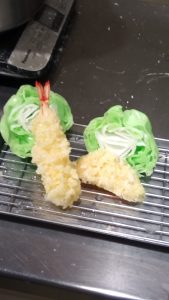
People riding the subway are almost always sleeping, listening to music, playing a game on their phone or some handheld device, or just staring off in the distance. It’s really rare to see anything other than that, and if so, it’s usually a small child misbehaving in some way.
Manners-wise, Japan is very similar to America. People appreciate it when you let them board the train first, hold the door for them, help them pick up something they’ve dropped, etc. I think the biggest difference between here and America is, for some reason, I feel like I get a lot more gratitude for every little thing I do in Japan. It was nice at first, but after I became accustomed to it, as Sarah warned us, I feel like I don’t know what’s really sincere anymore and what’s just polite. It’s frustrating at times.
Another thing is that Japanese people seem to make a lot less eye contact than Americans. I like looking at someone’s eyes when I talk to them because I feel like it makes me a lot more transparent in my feelings, but that’s much harder in Japan. I don’t know if it’s all the bowing that pulls eye contact or some other cultural factor but, again, it makes it difficult at times.
- For a interesting take on eye contact in Japan, you may want to read “Looking Another Culture in the Eye”
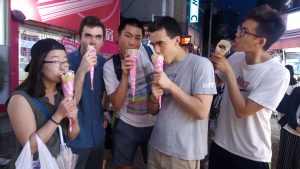
We talked a bit about wa, or harmony, in the pre-departure orientation. After coming to Japan, I think that’s what I’ve notice most behind how people act; it seems to all have to do with wa. From the amazingly punctual subway system, to the incredibly organized trash system, to how people act in public, to the constant gratitude, to the honorific and humble speech embedded in the language, it all seems, at least in part, to stem from a desire to be in harmony with others and nature. Even just walking through the streets, watching how the cars and people move, I get this weird sense that everything is moving together, in the way it’s supposed to. That’s one of the reasons I love just walking around Japan in my free time.
As time went on and people became more independent, I got the chance to get a lot more one-on-one talks with people. Don’t get me wrong, I love spending time with the whole group, but I always say that my favorite group size is 2, and I really enjoyed getting to know individual people better this week. I may have talked about this a bit in my last report, but I feel like the individual gets drowned out a lot in a group, so it’s nice to isolate people so you can really learn more about them. For example, on Monday, everyone left to explore somewhere while I was still doing laundry. So, Shivani and I got dinner together at this Indian restaurant. We were able to talk about the meaning of life, religion, and how you should live your life. It was the first time I’ve been able to talk so freely about my life philosophy, and it felt good.
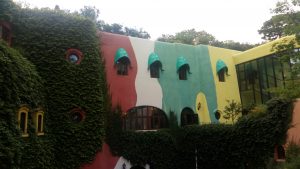
Aaron, Josh, and I went to Shinjuku one night and ate at this amazing and cheap ramen place. We met this guy named Toshiki, who taught us how to properly eat ramen. He was so friendly even though we didn’t know each other. I think I like the backstreets of Japan: good food and good company. This experience made me realize I really want to get to know more Japanese people better. I’ve been talking a lot with the U.S. fellows because it’s comfortable and they speak my primary language, but I want to step outside of that and get to know some Japanese people as well; most of them seem really friendly and cool.
There was so much more that happened this week, like making plastic food at Kappabashi, going to the Ghibli Museum, and exploring Harajuku. It was really fun, and I’m glad I got to spend it with the Nakatani group. Getting sappy again, sorry.
Overview of Week 3 of Orientation Program
Our speeches at the end of Japanese classes went really well, I think! I could tell that the people in the other classes had learned a lot since their last speech, and I hope it’s the same for me. I was able to present it pretty well from memory, which gives me hope that maybe one day I won’t be an awful speech-giver. I’m not really familiar yet with Japanese sentence structures, so I had to basically say the script word-for-word, which I don’t really like doing. I like having main points and just speaking based on them, which is what I usually do in English speeches (which may be why they usually end up badly). I hope I get the chance to practice public speaking some more, maybe in front of the lab, during this internship.
Professor Ishioka’s talk really stood out to me this week. She talked about women in engineering in Japan. I had no idea that the bias towards men in higher education was so strong in Japan; it was really eye opening. I also just recently found out that my lab only has one female member, so there’s the gap right there, I guess. Based on the data she showed us, it looks like things are getting better, but Japan still seems a far way off from equal.
- For more on women in science & engineering in Japan see our Research in Japan page.
Sunday was pretty tough. Lots of goodbyes. I also had to take my last nap on the Sanuki roof that morning. It’s going to be weird not spending basically 24/7 with the Nakatani group. I’ve really grown fond of them. Feeling pretty lonely as I type this out; I find myself already looking forward to the Mid-Program Meeting in Kyoto this July. I’ve become really used to having a native English speaker there if I need them, it’s going to be weird not having that anymore. Hopefully I’ll be able to meet up with them during weekends though, and Shivani is only half an hour away so maybe we can hang out on weekdays.
Arrival in Nagoya
I also met some people from my lab. Bien and Choi (spelling might be wrong…). They’re actually both Korean. It seems like my lab is very international, which is cool, but it presents a problem I didn’t think I’d be having. I’ve actually become pretty comfortable with Japanese these past couple weeks, but a lot of the people in the lab don’t speak Japanese, and speak English pretty poorly (or so I hear). I’m really bad at understanding things normally, so I feel like it will be a struggle to understand people in the lab. I guess that’s a major barrier in international laboratories. I’m interested in seeing how it plays out.
When I told them that I liked American food more than Japanese food, they seemed surprised. Apparently, they don’t really like Japanese food, and much prefer Korean food. I guess I’ll need to check it out sometime.
I’m looking forward to meeting the rest of my lab. I hope they’re all as friendly as Bien and Choi.
Once I got to my dorm the first night, I had most of the day off, so I went out and bought some essentials (paper towels, soap, shampoo, etc.) from a nearby supermarket that also has a Daiso on the second floor. It seems pretty convenient (about a 10 minute walk), so I’ll probably end up going there a lot.
My room is pretty big. I think I’ll have plenty of space to store my stuff, but it’ll probably get a little clunky if my organizational history is anything to go by. My bed came with some assembly required, and I’m almost positive I messed it up somehow (I have no idea what goes on top of what). The bed is also as hard as a rock, so I’m expecting some sore backs.
The area is really nice. Quaint, I think is an appropriate word. Not much going on in the area, and Choi said he didn’t really like it. On my first walk to the supermarket, I found some gaijin traps, a tennis court (hopefully I’ll find a way to be able to play on it), a nice park, and a Daiso plus supermarket.
After shopping the first time, I went on a second walk to explore. My walk ended up going for 3 ½ hours. Whoops. Everything is so far apart compared to Tokyo, so I kept seeing things in the distance and wanting to walk to them. Close by, there’s a curry shop, ramen restaurant, steak restaurant, the Daiso plus supermarket I ran into earlier, a barber shop (might have to try that out), a couple conbini, and a trading card shop (didn’t see a single one in Tokyo, was cool).
About a half hour walk out, there’s this place called Hill something or the other that’s basically a pretty big shopping mall. They have a food court, a bookstore, lots of clothes shops, and even a gaming arcade (with the Taiko drumming game!). Also, a bunch of bananas (4 or 5) is 150 yen! It would probably be fun to stop by there every now and again. I can also get there by subway if I’m feeling tired or lazy or just don’t have time. Also, there’s a Starbucks there so I could even do work there if I feel like it. There’s also karaoke in that area, but I doubt I’ll have the time or money for that.
I think I explored most of what’s within walking distance on one side of campus. There’s really not much to do around here, so hopefully I’ll find the time and can save the money to get out often. I’ll hopefully also spend a lot of time working out this summer, just using body weight if need be (I’m not sure what their gym’s like yet). Need to get massive and such. I also want to look for a tennis team. I saw one court, but I’m hoping they have more than that and some good players. I’d need to borrow a racquet and maybe some shoes, but I’ve been really itching to play. I know there’s also a rock climbing gym about 20 minutes away. That’s probably a little expensive for my budget, but I might stop by a couple times. Hopefully I can entertain myself for 10 weeks here, maybe things will seem better when I actually know my schedule.
My next-door neighbor stopped by to say hi. His name is Arya, and is an Indian research intern here for the next two months (same as me!) at the surfaces laboratory. I’m glad he took the initiative to come visit me; it was nice having someone come over to introduce themselves. He talked to me a little about how he’s struggling being in Japan because it’s his first time. I hope he’ll be able to learn some Japanese and be able to get around comfortably by the end of the summer. I also want to get to know him better. Hopefully I can be an outlet for him to speak some English!
I also started a budget. I divided up my remaining money and found out how much I can afford to spend per day. I’m going to log it all in an excel sheet to see how far above or below budget I am each day and overall. I hope to spend a lot less money on weekdays so I can do fun excursions on weekends that may be a little more expensive than I could otherwise do. I’m going to see what happens naturally the next few days then recollect myself and figure out what I should change to get the most out of my money.
Nervous for the next 10 weeks. There’s a lot to balance in research, free time, and money. I’ll try my best.
Question of the Week
I read today that the average Shinkansen delay is 54 seconds from its predicted time. That’s including delays due to natural disasters and other accidents. For a multi-hour trip, that’s amazing. The regular subway seems even more punctual. So, my question for the week is why? I talked about wa in my report this week, and used that to explain it, but it seems like a dodgy answer (I could explain almost anything using those principles), and I can’t believe that’s all there is to it. It’s a system that reminds me of the American obsession with efficiency, yet there’s nothing quite like it in America.
- “Ever Wonder Why Trains in Japan Aren’t Late? Here’s Why” (Kotaku)
- “Super Japan: On-Time” (Discovery Channel)
Research Project/Topic Questions from Prof. Stanton
Quick correction about my research before I answer the questions relating to Professor Stanton’s lectures. Single crystal means that all lattices are aligned the same direction, not that there is only a single lattice in the crystal. So, my material will be 3-D.
- Do any of the materials you will be studying this summer have unique or interesting optical properties?
- Not that we’re studying.
- Are there any interesting ways to probe your materials using optical techniques?
- We are using an X-ray diffractor, which finds the angles at which the Bragg condition (nλ = 2dsin(2θ)) is met. We are using this as a method to confirm that our samples are pure and aligned. Therefore, we are just looking for characteristic, sharp peaks.
- We will also (hopefully) use Angle Resolved Photo-Emission Spectroscopy (ARPES) to characterize the electronic structure of the material (Bi-2122).
I want to learn more about the floating zone method. It melts the sample and allows it to cool, which forms a single crystal, but I really don’t understand the mechanism very well. Slow evaporation causes more well-ordered precipitate when working with solutions because it gives the precipitate time to form a well-ordered, low energy configuration, but does the same logic apply to solidification? I feel like I don’t really have a good enough understanding of solid state physics or crystal lattices to know how it works exactly, so I want to read up on it some more this summer.
I also still want to develop a better understanding of reciprocal lattice space. I can see its usefulness, but the math still goes way over my head.
Then, of course, I want to know more about superconductors. I understand the basics (Meisner effect, formation of Cooper pairs, which act as bosons, etc.), but it still seems like magic to me. Hopefully this summer will allow me to understand them a lot better.
Return to Top
Week 04: First Week at Research Lab
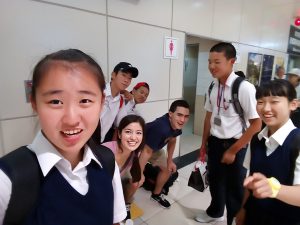
My first day in the Energy Materials Lab at the Toyota Technological Institute (TTI), I arrived (10 minutes early, of course) and introduced myself to Takeuchi-sensei and my mentor. Takeuchi-sensei is really kind, and obviously knows a lot about solid state physics and science in general. He told me that every Monday, someone from the lab presents what they’ve been working on in front of the rest of the lab, and invited me to join.
Dr. Robert Sobota (he makes me call him Robert) is a Slovakian working with me on single crystal Bi-2212. He is very direct and to the point, but definitely friendly and clearly cares about my growth as a scientist and person. He doesn’t speak Japanese at all (same with a surprising number of people at the lab), so I find myself speaking almost exclusively English at the lab. As time goes on, I’m starting to gain a real appreciation for how much he (and Takeuchi-sensei and everyone else in the lab) knows. I want to learn as much as possible from this lab in the time that I have, and I’m realizing that a lot of that will just be listening to what the people in the lab have to say to me and teach me.
Because everyone was at this meeting, it was the perfect time for me to introduce myself. The lab is incredibly international. The people working here come from Japan, Korea, China, Taiwan, Slovakia (my mentor), France, India, and now, America. Because of this, I was able to (had to?) give my self-introduction in English. After that, each person in the lab went through and introduced themselves to me. I’m still struggling to learn/remember names; there are about 20 people in the lab. Because the lab is so international, English is the main language, but there’s definitely a language barrier that needs bridging at times, which tends to slow things down. I’m interested in seeing how the people in the lab overcome this barrier. In an international lab, this definitely seems like it would be one of the biggest (if not the biggest) struggles in collaboration.
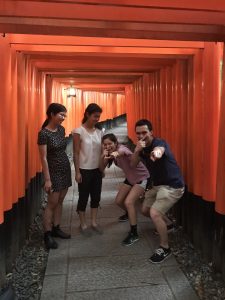
After that, I went to the TTI office to talk about basic information for living here. It turns out that there is a tennis club, but they only practice once a month because there are no courts on campus. It’s a shame, but I don’t want to be spending all of my time playing tennis, so it might be a good thing for me. She also told me about the iPlaza, which is a place I can take Japanese language classes and speak with people trying to improve their English.
Then, I went back to the seminar room and listened to the end of this week’s presenter’s presentation. I came in halfway through so it was a little difficult to understand, but it wasn’t nearly as abstract as I expected it to be. I hope this is a sign that I’m finally gaining some sort of understanding, but maybe it was just a coincidently concrete topic. Who knows. There was still a lot I didn’t get.
Then, I got lunch. A large group of the lab, including my mentor, all go together at around the same time each day. The food is incredibly cheap (less than 450 yen for almost everything) and pretty filling, too. It seems like everyone here goes to lunch together, eats together, and leaves together. It forces me to eat more quickly than I normally would, because I don’t want people to have to wait for me. I’m not sure how I feel about this. I generally like going about things at my own pace, and while it’s nice that the lab tries to build this sense of camaraderie, it will most likely be difficult for me to do this kind of stuff all the time (I need my alone time).
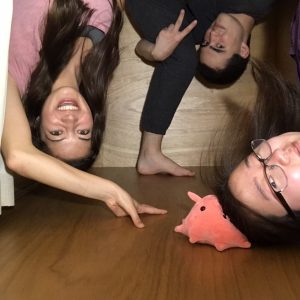
Takeuchi-sensei, Robert, and I talked about what I’m going to be doing this summer. He explained the theory and told me my project. I will be making Bi-2212 single crystals (all aligned in the same direction) doped with Y and Pb (to change the number of holes in the superconductor) using the floating zone method, and analyzing the crystals’ properties including resistivity, Seebeck coefficient, and magnetic susceptibility by PPMS (Physical Property Measurement System, I think), and electronic structure by ARPES (Angle-Resolved PhotoEmission Spectroscopy). We will use XRD (X-Ray Diffraction) and TEM (Transmission Electron Microscopy) to test whether the desired crystal is obtained. However, the ARPES machine is being repaired right now, so it’s undetermined if I’ll be able to use it, which is unfortunate.
I will prepare samples, run XRD, PPMS, and (hopefully) the floating zone method machine (not sure of its name). I will also perform ARPES if the machine is fixed before I leave. Robert will train me to use do all of these things.
The transport properties of superconductors change with hole concentration, and it is my mentor’s research interest to characterize this theoretically and experimentally. I will be helping with the experimental portion.
My research seems really time consuming. It apparently takes weeks to prepare a sample of Bi-2122 and 10-12 days to align it into a single crystal. It sounds like the next few weeks are going to be a lot of grinding, heating, and re-grinding. It’s scary, because it sounds like I might only be able to prepare and analyze one or two samples in my entire stay here, meaning messing up will leave me with almost nothing. I’m also concerned about how I can make that few data points into a project to present at the end of this program.
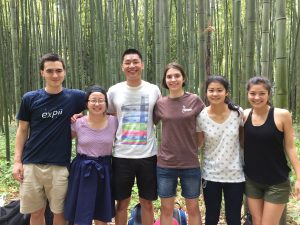
So, if possible, I also want to find something interesting and maybe explore it on my own while I wait for things to get done. Unfortunately, my options are very limited because samples take so long to prepare, equipment is limited, and I know very little about the topic right now, so it will probably hard to come up with something worthwhile. That said, I have been meeting with Takeuchi-sensei every morning at 9 am to talk about theory for about an hour. It has been ramping up recently, but I’ve been keeping up fairly well so far, I think. I want to gain not only a basic understanding of solid state physics and superconductors, but one that will allow me to think critically and ask my own questions about them. I can turn that into an independent project.
After our meeting, Robert showed me a few of the basic procedures I’ll have to do to analyze my sample once it’s finished. We prepared a sample for XRD and ran a magnetic susceptibility test by PPMS. The PPMS will be down all of next week for maintenance (more unfortunateness).
It looks like my hours will be 9-7 about every weekday, with nothing on the weekends. It’s quite a bit and can be exhausting at times, but certainly one of the better schedules amongst the Nakatani Fellows (especially the free weekends). At least this first week, there was a lot of down time because my sample has to sit in the furnace until Monday. I found some books and textbooks that I want to read in the meantime.
I also want to start writing out my thoughts so I can better consolidate and work on improving my philosophical ideas. I want to grow as a person this summer too, not just intellectually, and, so far, I feel like it’s been really helping me in figuring out exactly what I think, why, and what I still need to figure out. Unfortunately, my first paper took about nine pages to answer one question, and after one week I have a list of 14 questions I want to answer (and the number keeps growing). I know I’ll always need to be working at this stuff for the rest of my life, but with how long lab is, I wonder if I have enough time to get everything I want done this summer. It’s frustrating at times, because I feel like I just need more time in the day.
Reflections on the Orientation Program in Tokyo
I really, really enjoyed the orientation program. There were a lot of cool programs where we got to learn about Japanese culture (sumo!), Japanese classes where I got to hone my speaking skills more than I’ve ever gotten the chance to before, a ton of interesting lectures from professors and other experts, and yet a lot of free time to explore where I wanted to explore. Of course, the company was great too. I know it’s unrealistic, but I only wish it had lasted longer.
I think it was a great chance to learn about Japan before going to my host lab. From language classes and just from being around, I got to learn the basic manners of Japanese culture. I certainly would not want to learn those by trial and error in my lab. I also got a better sense for the railway system and navigating my way around, which has already come in handy for my trip to Kyoto this past weekend.
Living on my own this past month, and especially this past week, I’ve learned a lot about my priorities. After lab, I only have a few hours before I need to go to sleep, so it’s really important to figure out what I really want/need to do with that time. I hope that through this experience, I can discover myself and my priorities even more, which will hopefully only accelerate my growth.
Question of the Week
According to the people I talked to, Kyoto is a largely bus-based city, with trains only running along the outskirts. In contrast to that, you can get almost anywhere in Tokyo by train. The area around Toyota Technological Institute in Nagoya appears to be mostly walk/car based, which makes sense because things are more spread out, but Kyoto and Tokyo are both major cities. So, my question is, why did these cities develop such drastically different methods of transportation? I’m also interested in knowing the advantages and disadvantages each of these methods have shown through time.
- Just like in the U.S. there are more rural areas of Japan and smaller cities that are much more car dependent than you might expect after having been in Tokyo. Also, many university campuses, like TTI, are built in outlying areas where there is more free land and it is cheaper to build. This means that subway lines and major bus routes may be more focused on the city center in Nagoya rather than the area you are living in now. Ask your labmates or at the iPlaza what the best bus routes are to use in and around TTI as the other students there may have helpful tips for you.
- To make the investment in a very extensive subway/train system worthwhile you need a very high population density and ridership each day. Also, Tokyo does not have much land to spread out into. The sea is on one side, the mountains on the other, and the price of land is very expensive. And this not new, it has been this way since the Edo period. Therefore, the opportunity cost of putting in large street/freeway networks and parking for cars is much higher.
- Comparatively, in Kyoto which has been the historic cultural center and capital of Japan there are many sites of historic and cultural significance that could be damaged or destroyed by the vibrations from digging deep subway routes. If you are putting in a new route and unearth a site of historical/cultural significance you may need to stop progress for a long time for archaeological excavations. Therefore, in Kyoto it can be easier to just expand the bus routes rather than build deeper and more extensive subway routes. Kyoto was also not bombed during WWII, meaning that its historic and cultural sites survived.
- This did not apply in Tokyo because, during WWII, the U.S. firebombed Tokyo destroying vast portions of the city and killing 100,000 civilians. For more, watch this BBC news report (video) or start watching this newsreel footage at 1:45 for images of what the fire storm looked like. Nagoya, Osaka, and Kobe were also firebombed after Tokyo. Therefore, Tokyo and its transportation infrastructure had to be almost entirely rebuilt after WWII.
- You may also want to read a bit more about the history of Nagoya to learn about how the city/region developed.
Weekend Trip to Kyoto
I mentioned my trip to Kyoto this weekend. It was a lot of fun, but seemed so short, and I probably won’t be able to travel again until the Mid-Program Meeting, so it’s a little bittersweet being back in Nagoya. I know I’m only supposed to put in three pictures each week, but so much happened I can’t help but share more! I guess, pick your favorites and put them in the report, if need be.
Thanks for a really fun trip, Nakatani Fellows. Can’t wait to see you all at the Mid-Program Meeting!
Week 05: Critical Incident Analysis – Life in Japan
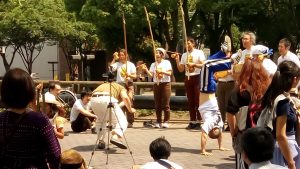
I think the time where I had the largest difficulty due to cultural differences was during the second week of orientation, right after watching sumo. The Nakatani Fellows (minus Aaron) all decided to go to a chankonabe (giant hotpot, basically) restaurant. We got split into two groups, and as the Class 4 representative of the table, I was designated as the person who had to communicate with the server.
Honestly, I don’t remember it all too clearly because it was just under a month ago, but I’ll try my best to report things accurately. The group wasn’t very hungry as a whole (a couple people even said they weren’t going to eat at all), so we decided to get one pot for the whole table. But, when I told (or tried to tell) the server that we were ordering one pot, he shook hand and said that we should (needed to?) get at least two pots. I tried to tell him that we weren’t very hungry, so one would be fine, but he kept insisting, so we ended up getting two pots. I’m still not sure if there was some rule of the restaurant where you need to order at least a pot per three people or something of the sort, or what. In retrospect, though, one pot would’ve been far too small.
A similar thing happened when we were ordering drinks. I told him that water was fine for everyone, but he kept shaking his head and gesturing to the drink menu. So, everyone at the table ended up having to order a (fairly expensive) drink.
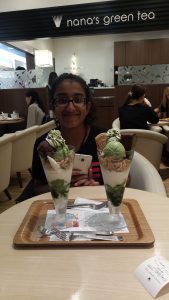
The server seemed annoyed at our incompetence, and the whole thing left a bad taste in my mouth. The server didn’t understand any English, so he must have been frustrated with our lack of understanding. On the other hand, I was confused about the rules of the restaurant, and even suspected that we may had been scammed into ordering the drinks because we were foreigners. It didn’t feel like the server was trying anything malicious, but I just felt really confused the whole time.
I wonder what I could have done differently? I didn’t want to keep wasting people’s time by repeatedly asking questions and getting responses I didn’t understand, but, at the same time, I really wanted to figure out what was going on. I wanted everyone to get their food on a reasonable time-scale, and certainly didn’t want to bother the server, so I ended up mostly following the server’s instructions, but I wonder if that was for the best; after all, I never did figure out what was going on.
[Maid or Speciality (e.g. cat/owl)] Cafés here tend to require you to order a drink in addition to the entrance fee to sit down, so I wonder if it was a similar thing, but it was a big restaurant and we were already ordering food, so it seems strange. Language barriers tend to be the most frustrating for me, and seem to lend a lot to these types of situations. Just another reason I want to learn more of the language.
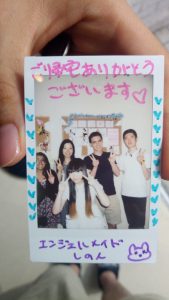
It’s possible that what I really need for situations like that is better preparation. Learning more about what to expect from places like this might be the best way to avoid these situations, because I’ll know what to expect. I guess, then, this experience was really a wake-up call about how much I still have to learn about Japanese culture. I know I can’t be expected to learn it all, especially in two months, but that’s no excuse for ignorance.
I explored a bit of Nagoya this weekend with Shivani, Tomo-chan, and Tom-san. Here are a few pictures.
Question of the Week
I notice a lot of parents and children, siblings, couples, and even just friends walking around wearing the exact same outfit, or at least shirt. In America, it’s cute to “match” with someone you care about, but usually that is just wearing the same color or patterned shirt, often by coincidence. This trend in Japan takes it to a whole new level. So, my question for the week, is why?
Yes, this is a thing in Japan (and in countries like South Korea too). For more on this see They Love Wearing the Same Outfits! Japan’s Osoroi Code (Wosabi) under our Fashion in Japan section on the Life in Japan resources page.
Research Project Update
Still in the sample preparation phase of my project. I have to heat my sample up at increasing temperature a couple more times, and then I’ll put my sample in the floating zone machine to finally get my single after two more weeks.
The PPMS will finally be out of maintenance on Monday, so I will get the chance to operate that on some of Robert’s samples. The ARPES is still out of commission though.
In the meantime, I’ve been helping Robert out with the preparation of his samples (he hasn’t been able to do much analysis either), running some XRD’s, and learning some useful programs, such as Origin and FullProf. I was also given the opportunity to watch someone perform TEM, but I probably won’t have time to actually learn how to do it this summer.
The first two weeks, Takeuchi-sensei also taught me the basic theory behind what I was studying and the techniques I would be using. It was really amazing to get so much one-on-one time with a professor; it’s an opportunity that not many people get so early. I think I was able to learn a lot in a short period of time.
I’m anxious to get my first sample prepared so I can finally start generating results. I know this is the nature of research, but it’s stressful only having two months to try to produce something meaningful.
Week 06: Preparation for Mid-Program Meeting
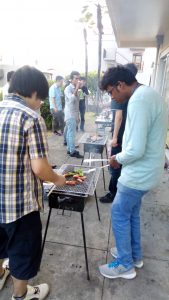
Other than my lab mates, I hadn’t really talked much to my lab mates. They are always friendly and responsive when I have questions about lab or Japanese, but that was about the extent of my discussions with them. Whenever I’m not doing something in lab, I occupy my time by reading or learning out of a textbook; talking with another person about interests and the like seems inappropriate. A bunch of us always get lunch together, but most of my time is spent eating, and we head back as soon as everyone is finished, so I don’t get much time to talk with them.
This Friday was my welcome party. It was a “barbeque” where all of the members of the lab grilled from their native countries. It was amazing how much delicious food there was. At the welcome party, I finally took the initiative to approach and really talk with a lot of the lab members for the first time. It was great having these people usually so focused on their computers and lab work have personal discussions with me, hand me a plethora of foods I would’ve never thought I’d eat (a couple of which I don’t plan on eating again), and even pull a prank on a post doc to try to get him to fall off the couch (he had tried to lean back earlier when there was no back rest, and the other lab members wanted a repeat performance). I got to eat mochi, “rare cheese” (basically cheesecake with the texture of tofu?), fish eggs (super salty), these delicious thin noodles dipped in ice water and then sauce (can’t remember the name), and so many other foods. I even convinced some of the lab members to visit a maid café for the first time this weekend (I really hope they were serious about it).
I think I’ve finally broken down a sort of wall which I didn’t even know existed between me and the other lab members. I hope that in the coming weeks we’ll be able to talk much more freely, whether it’s in lab or out.
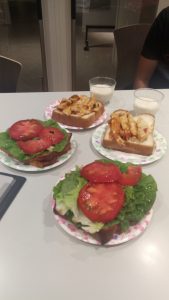
My biggest personal challenge right now is probably keeping my motivation levels high for things outside of lab. After 10-12 hours in lab every day, I get back to my dorm room and just want to pass out on my bed, and sometimes I do. The mental exhaustion has a big effect on my physical energy, and I definitely feel it becoming harder to convince myself to take a walk to explore and look for something interesting to do, work out, or even just ponder something that’s been on my mind. I also have a couple pieces I want to learn on the piano, but I get home so late I can’t play because it would wake up the other people in the dorm, which is frustrating.
Because I feel pressured to always be active while I’m in lab, it’s possible I’m overworking myself. I wonder if I should take things down a notch in lab by spending a little of my free time each day just resting so I can get the most out of my time out of lab. It’s hard to say.
Research is going according to the timeline. Aside from dropping my sample or accidently heating it a little too hot and having it melt and react with the crucible (which happened the last time my mentor tried to prepare this sample), there’s not much that could disrupt the timeline. I’m trying to take really good care so I don’t do the former; I just have to cross my fingers that the latter doesn’t happen.
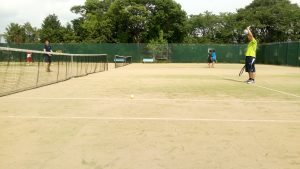
Question of the Week
I was finally able to attend practice with the tennis team here! Everyone was really nice… too nice. Whenever I hit even a halfway decent shot, they would compliment me on how good I am at tennis, or how good my form was. I’ve actually noticed it a lot from Japanese people. I will say a simple sentence in Japanese (even just “hai,” once), and they’ll tell me how good I am at Japanese. I know they mean it in the best way, but a lot of the time it feels like I’m being spoken down to, like I’m being patted on the head for walking on my own for the first time.
I know that Japanese culture has a lot of lowering the position of the speaker while raising that of the other person (they even have special verbs for such occasions), but this level of praise is something I haven’t really observed between Japanese people (although maybe I’m not looking hard enough). So, I guess my question for the week is why do Japanese people put so much effort into praising people like me (I hesitate to generalize this to foreigners in general, because I really don’t know) when they don’t do so to each other? Is it just because I’m a “guest?”
- 5 Reasons Foreigners Find it Hard to Become Friends with Japanese People (JapanToday)
- The Gaijin Complex (GaijinPot)
- Uchi-Soto in Japanese Culture (GaijinPot)
- The Honesty and Façade of Honne and Tatamae (GaijinPot)
- What are Clubs and Circles? (Univ. in Japan)
- 5 Ways to Make the Most of your Study in Japan (GaijinPot)
- University Clubs/Circles in Japan (JP info)
- Experiencing Japan’s Senpai-Kouhai Relationship at Work (GaijinPot)
- The Senpai-Kouhai Custom in Japan
Research Project Update
Not much going on this week in my lab. The PPMS was finally working again, so we were able to run resistivity, Seebeck coefficient, magnetization on a single crystal sample that just came out of the floating zone furnace. It was a lot of loading the sample onto the plate and just hitting start on the program, so it’s mostly soldering and cleaning tiny circuits (not good for my shaky hands).
Other than that, I just spent the week preparing samples. It was a lot of grinding compounds together, and my lab mates even noticed and commented on it at my welcome party this past Friday. It’s a little tedious spending all my time doing the same tasks over and over again, but the plan is to finally put my sample in the floating zone furnace by the end of this week, so hopefully a little bit after the mid-program meeting I’ll be able to do some analysis.
In my free time at lab, I’ve been trying to do some reading and re-learn linear algebra from a proof-based perspective. I’m doing every single problem in the book, so it’s really slow-going, but I think I’m really learning a lot about the thought process behind proofs. Although, looking at the answer key and talking with the other Nakatani Fellows, I definitely have a bad habit of brute forcing the proof when there are clearly much more elegant ways to do it. I’m not the kind of person that tends to get flashes of inspiration though, and I’ve been solving the problems at a pretty steady rate, so I think it’s okay, though.
Next week, I’ll prepare my sample for the floating zone furnace, continue to analyze the single crystal we worked with last week, continue preparing new samples (so I can get multiple data points by the end of the summer), and hopefully learn how to do Rietveld analysis with 2 phases.
Return to Top
Week 07: Overview of Mid-Program Meeting & Research Host Lab Visit
The Mid-Program Meeting was a welcome break from lab and a great chance to explore Kyoto with the other Nakatani Fellows. It was nice to see everyone back together again after almost a month. Even though I visited Kyoto a couple weeks ago, the places we visited during this trip were different, so it felt like I was exploring a completely new city, which was cool.
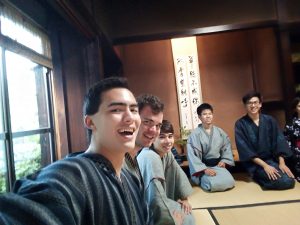
Of the planned events, I think what I most enjoyed was the tea ceremony. We experience a lot of modern Japan and generally only get to see the more traditional side in the form of places like temples, so getting to participate in traditional Japanese culture was really exciting. It was especially fun to get my own yukata, and serving the tea we made to the Japanese Fellows I thought was a nice way for us to show our respect for the culture and that we are actively trying to understand it and be a part of it.
But that’s enough talk about that. Touring Kyoto University was also really cool. They have a big campus and lots of fancy equipment. It seemed like a nice place to do research, so I’m glad for the Nakatani Fellows there. I hope they’re enjoying it. I’ll keep this one short because this section has gone on a while, but the Sysmex headquarters in Kobe was also a really cool place to visit. It was setup for people like us to visit, so they had demonstrations and had example machines that you could see the inside of. A lot of times, you just see a large block and what’s cool is what you’re told it does. In this case though, we could actually see the experiment in action. There were a lot of other awesome planned things we got to do on this trip, like a visit to Kitano Tenmangu, a really historically rich and unique temple.
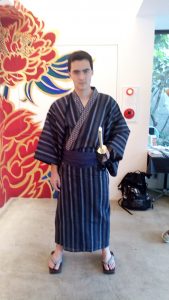
Something I really appreciated about the Mid-Program Meeting was how much free time we were given. There was a lot of time to spend with the other Nakatani Fellows, and I really just enjoyed being with them again and being able to hang out. Notable activities were karaoke, bowling, and the Path of Philosophy. Some Japanese and US Fellows went to karaoke together on the first night. The Japanese Fellows were only around for the first day and a half, so we wanted to spend as much quality time together as possible. It was great fun, and all of the Japanese Fellows were actually really amazing singers. I even got to learn some new Japanese tunes (Linda Linda, check it out).
After the presentations and tour at Kyoto University, most of us went bowling together at a place not too far from the hotel. It was really fun to cheer (scream) at the top of my lungs at every pin knocked down; it was good stress release and it’s been a long time since I’ve been able to do that. The couple next to us was also incredibly amused. I was glad we could spread a little bit of our joy to those around us. Regrettably, I got the lowest score (40 points, which is actually pretty good for me, haha), as usual, but I had a great time doing it. Also, shout out to 2016 US Fellow Erica Lin for showing us around and keeping us in line.
Last time I visited Kyoto, I read about this apparently beautiful walk called the Philosopher’s Path (PP, from here on). Unfortunately, it was a little far away, and we decided not to go in the end, which was a huge disappointment. This time around, though, we were in walking distance (30 minutes, about) of PP, so, naturally, I walked it twice. The first time, I went with Jakob and Katelyn, and the second time with Jakob, Katelyn, Savannah, and Josh. The PP itself was actually very plain: a small sidewalk made up of rectangular stones alongside a calm river. There were houses and streets on either side of us, and no spectacular views anywhere. As Jakob pointed out, the name is actually incredibly fitting. We, of course, had some deep conversations about life, values, and the like. Although I can’t disclose anything specific, these walks have actually been very impactful on me; I realized some things about myself I want to look into more and feel like I connected with the people I talked to on a really personal level. Definitely a place to return to sometime, if I get the chance.
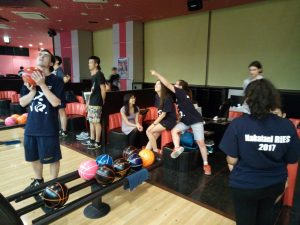
Mid-Program Meeting Research Introduction Presentation
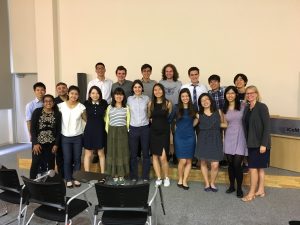
As part of the Mid-Program Meeting, on Monday, July 3 our 12 U.S. Fellows gave a presentation at Kyoto University introducing their research project and future plans. William presented on the research he is doing in the Energy Materials Laboratory at the Toyota Technological Institute entitled “High-Tc Superconductors – Bi2Sr2CaCu2O8+δ”. Click here to download a PDF of his presentation.
Of course, I can’t talk about the Mid-Program Meeting without mentioning the presentations. I had never given a scientific talk before, so I was actually pretty stressed out about it. I also very quickly realized how much I wanted to say and how little time (5 minutes) I had to say it. The week before the presentation, I walked to the Hill’s Walk place I (think I) talked about a while ago every night after lab. They have a nice little roof, so I went up there to get some peace and quiet and to revise and practice my presentation. My mentor and Takeuchi-sensei also had a quite a lot to say about my first draft, so I ended up putting in a lot more work than I expected for a 5-minute presentation.
That said, I felt like my presentation ended up going pretty well. The presentation was apparently understandable and the pacing was good. I got the 1 minute left signal from Sarah just as I was turning to my last slide, so I had plenty of time, but I felt like I rushed through it anyway. It’s a shame because I wanted to have a solid conclusion, so I feel like I should have put in some of what I cut for time. This may be due to my inexperience, but I felt like the flexibility wasn’t there. If something went wrong, I’m not sure what would have happened. Besides that, I felt like I should have been better prepared for questions; I thought my answers weren’t as good as they could have been. Sarah also mentioned that, especially because this was after only one month of research, I should have been less result-oriented in my speech. I fear that my frustration in the time it takes to prepare a sample bled through into my presentation.
I also really enjoyed everyone else’s presentation. I watched a lot of them practice before, so I knew they were going to be solid presentations, but when everyone presented in a row I was really able to notice how each of them had their own style, their own personal take on what a presentation should look like. It was really interesting to see how each person seemed to want to accomplish something completely different with their presentation, despite them only being 5 minutes and all of us receiving the same prompt. We even discussed them quite a bit during the creation process.
Overall, this experience prepared me in a lot of ways for the rest of the summer. I felt myself losing focus the past couple weeks, but through a combination of giving that presentation, talking with the other Fellows, and touring Kyoto, I feel more ready than ever to finish my research strong. It was just another reminder of how incredibly blessed I am to be in this program.
Host Lab Visit
The night I got back to Nagoya, I had dinner with Sakaki-sensei (the president of TTI), Takeuchi-sensei (my professor), Kono-sensei, Sarah-san, and Ogawa-san. Needless to say, I felt a little overwhelmed being surrounded by a group of powerhouses eating the best meal I’ve ever had. They tried to keep me involved in the conversation, and I got to hear some very interesting opinions on the state of education in Japan and America from some of the people who know about it best. I also had no idea that Kono-sensei and Sakaki-sensei had been friends for a long time. It was probably that relationship that allowed me to do research here. There’s the importance of connections right there.
The next morning, Sarah-san, Ogawa-san, and Kono-sensei visited my lab. It was a good test of my knowledge to actually try to explain the machines to someone else, and I definitely found some gaps I need to brush up on. My lab has a lot of good equipment, so it was nice to be able to show that off to someone. It didn’t take long to show them everything I was doing, which was a little sad, but it’s a lot more than it seems when I’m doing it on a day-to-day basis. If nothing else, I’m gaining experience on how to use some very useful machines.
Question of the Week
Like I said earlier, at dinner with Ogawa-san, Sarah-san, Kono-sensei, Takeuchi-sensei, and Sakaki-sensei, we talked a lot about education in America and Japan. One thing that came up was the incredibly low Bachelor’s to Ph.D. turnover rate for certain major’s in Japan, possibly because a steady job in industry is so attractive. In contrast, American careers have been moving more towards a lot of short term work, where someone only works for a company for a few years before moving. My question for this week what are the pros and cons of each system, especially with respect to the productivity of the company and individual satisfaction? For example, the longer someone stays with a company, the more experienced they are with that specific field, so you would expect them to become more efficient. On the other hand, constant competition for the job may increase motivation and effort, also leading to higher productivity. And a follow-up question: why have America and Japan been separating in this way? Job security is an important thing for everyone, so what specific factors have caused Japan to stay with the “hire for life” philosophy while America has moved in the opposite direction?
- Excellent questions. You might want to read through some of the articles under the ‘Career Resources for Science & Engineering Students’ tab on our Other Related Programs page and the Work Ethic & Job Hunting section of our Life in Japan page. The Education in Japan section might also have some articles relevant to these questions.
Research Project Update
Finally put my powder in the floating zone furnace to grow my single crystal! It takes 10-12 days to grow, so I’ll have to remove it on Monday. The ARPES is also officially fixed, and will be ready to use in 2 weeks, so I’ll finally get the chance to use it.
Other than that, I’ve been learning how to use the PPMS recently, which is 99% setup and 1% pressing buttons on the computer. The setup is placing a sample on a tiny circuit board then attaching wires to it. I’ve never had the most stable hands, and up until now I’ve tried to avoid electrical work as much as possible, so needless to say I am quite bad. It’s a slow, painful, and frustrating process, but I’m slowly learning the tricks and gaining experience, and I can feel myself slowly getting the hang of it. It’s nice to have something at lab I can’t do perfectly my first time through, but instead need to practice and think about to get just right. I’m officially making it a goal of mine to be able to run one of these experiments on my own by the end of the summer.
My mentor is leaving on Monday for Kyoto, and won’t be back until Thursday afternoon. This means I’m going to be on my own for a while in lab, and just at the critical time when my first single crystal is being prepared. It’s scary, but I’m excited to have complete independence for almost a full week. This may be about as close as I can get to what real research is like this summer.
Overall, I’m just glad to finally be in that exciting part of research where after working for so long I can produce results. Let’s hope I don’t destroy my sample.
Week 08: Research in Japan vs. Research in the U.S.
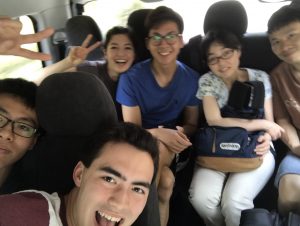 In general, the people in my lab tend to keep to themselves. They talk to each other basically only when they have a question, want to make sure no one is using a machine they want to use, or want to point out something that’s being done incorrectly/unsafely (I get that one a lot…). Of course, people work together and there are small friend groups, but even then, most discussion seems to be about work until after around 9pm, when people start chatting more. People chat a little during lunch, but most of the time is spent eating, and people often stay behind to run experiments.
In general, the people in my lab tend to keep to themselves. They talk to each other basically only when they have a question, want to make sure no one is using a machine they want to use, or want to point out something that’s being done incorrectly/unsafely (I get that one a lot…). Of course, people work together and there are small friend groups, but even then, most discussion seems to be about work until after around 9pm, when people start chatting more. People chat a little during lunch, but most of the time is spent eating, and people often stay behind to run experiments.
People are passive in the sense that they generally don’t approach each other for reasons other than lab, but they definitely aren’t scared to disagree with each other. When a disagreement occurs, usually one lab member is “clearly” (I put this in quotes because it’s typically obvious neither to your average Joe nor me) right, and ends up explaining something to the other person. When a real disagreement occurs, they usually argue it out in the office. It’s respectful, but people definitely don’t hold things back for the other person’s feeling’s sake. There’s a whiteboard in the office that is often occupied by people working through a disagreement.

Based on Orientation, I expected the lab to be a lot more passive and for me to have to read a lot subtler cues to understand things. I’m glad that I learned about how “maybe yes” actually means “yes,” and that “maybe no” actually means “no,” though. To be fair, I am in an international lab, and a lot of the most passionate discussions are definitely between members from countries other than Japan. I think if I look just at the Japanese members of the lab, they tend to be a bit more timid when starting conversations, but also more relaxed and comfortable chatting in lab. This second point surprised me a little bit, just based on how everyone always talks about how serious the Japanese workplace is.
Someone mentioned this at the Mid-Program Meeting, but I have definitely noticed that the Japanese mindset is very result-oriented. I don’t really know how it compares to the US, but there’s a lot of talk about showing that your project is potentially useful and that what you’ve done shows the potential is possible. I feel like this would be true in any lab, though, because you have to convince people that your project is worthwhile to get money. Takeuchi-sensei and my mentor try to keep my focus on learning the concepts and techniques rather than getting results, though, which is nice.
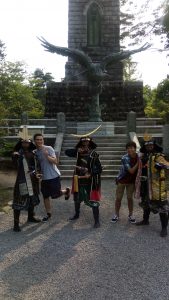
My work in other labs has been a lot more independent than it is here. I was usually the only person in lab at any given time, so I just ran my experiments and left. This is probably not very indicative of a typical lab in the US, based on what I’ve heard from the other US Fellows, so it’s tough to say which environment I would prefer. I think, though, that I would much prefer the environment in the US, if not solely because of the time in lab. In the US, people generally work until 5pm, and then leave. In Japan, though, you stay, in my lab, until at least 7pm (usually 8 or 9pm), even if you’re done with your work. As I’m writing this, actually, I’m sitting in the office at 6pm with nothing to do. But, I feel obligated to stay. And while I try to make this extra time productive, I lose a lot of freedom in those few hours every day, and it adds up. Sometimes I just want to take a nap or watch a YouTube video to take a break, but I can’t do that when everyone can see me “slacking.” Especially because I’m a guest, I feel like I need to always look productive. I’m someone who values freedom very highly, so I’d imagine I would prefer the American system, where I can go home and do my own thing when I’m done with my work.
I’m not sure there’s a single experience that describes my lab well, so I’ll just talk about the most memorable one for me. Every week on Monday, we hold a seminar where one of the members of the lab presents a recent paper relating to their work, or their work itself. One week, a new member of the lab had to present. His English wasn’t very good, and it didn’t seem like he prepared very well for the presentation, and my lab just tore him apart. There were over 3 hours of questions, and I really just felt really bad for the guy. It was only the second presentation I watched, and everyone seemed so nice before, so I was really shocked and honestly a little scared. I don’t know what I would’ve done if I had been in his place. It really showed me how important it is to be prepared and present good work; you have not only your own, but also your lab’s reputation on the line with everything that you do.
And yet, after it was all over, people stood up, stretched, and started commenting light-heartedly about how it was already a couple hours past lunch time, and there would be no food left in the cafeteria. The mood had been so dark (at least it seemed to me) in the room before, but it changed completely in that instant. My mentor talked with the presenter down at the whiteboard for about an hour afterwards to explain things that were still unclear at the end of the meeting, and everyone acted just as friendly towards him afterwards as they did beforehand. People in my lab can get really serious about the quality of the work, I suppose that’s inevitable in any good lab. But, despite how it seemed to me at first, the criticisms they have are for the purpose of improving the person’s work and helping them improve, not putting them down. I guess if I had to stick a motto onto my lab, it would be: work hard, help each other, do great things. Just corny enough.
Question of the Week
Been bothering me for a while, actually. At home, I feel like I get the majority of my liquid intake from water fountains, which seem to be everywhere in America. In Japan, I’ve seen maybe one or two. Simple question this time: why are there so few water fountains in Japan?
- Probably because there are so many vending machines and conbinis in Japan. Would you rather have ice cold water from a vending machine or hot/warm water from an outdoor fountain that may or may not taste funny if the pipes are a little old. Also, since the cost for bottled water is usually just 100 – 120 yen it is not as cost prohibitive to buy bottled water as it in the U.S. where vending machines can charge $2 – $3 for bottled water or soda.
Research Project Update
Unfortunately, the growth of my single crystal had to be stopped too many times during the process, so it wasn’t very straight. We suspect that the crystallinity isn’t very good because of this. I was also only able to get very small pieces of single crystal off of it. So, I’m going to have to grow another single crystal, which will take another 10-12 days in the floating zone furnace. Frustrating, but it just means I’ll have to be even more careful with my preparation this time to make sure it goes right.
In the meantime, I’m going to analyze what I got. The ARPES is still baking, so I can’t use that yet, but I should be able to run XRD and PPMS measurements on my crystal, if I can find enough single crystal pieces.
Dr. Sobota is out until Thursday afternoon, so I’m on my own running everything until then. It’s scary, but also really great. I have things I need to do, and I can do them at my own pace. Having complete independence like this makes me feel like a real researcher.
By next week, I should have collected some data on my sample. I’m really excited to finally see the results of my past month’s work.
Return to Top
Week 09: Reflections on Japanese Language Learning
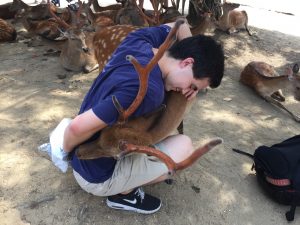
I, in all honesty, haven’t learned too much Japanese this summer, at least in the sense that I haven’t learned too many more grammar structures or vocabulary (although the language classes were helpful for that). What I’ve gained through my experience in Japan is a more practical knowledge of the language. Through speaking with native speakers, I learn a lot more about what I don’t know and how to work around these gaps in knowledge on the fly. This could be trying to form a sentence in a grammar structure that is easy for me in English but is a little more complicated than I first thought in Japanese, or, and this one happens to me a lot, I’ll say something in Japanese that I think makes perfect sense, but confuses the native speaker or communicates the wrong message. It’s in these moments that I realize how limited my Japanese capabilities really are, which is humbling. At the same time, I can feel my ability to handle these situations slowly improving as I encounter them, whether by explaining things more explicitly, taking more time to think what I say through, or just knowing what I did wrong last time and fixing it (often it’s just a matter of Japanese vs. English idiom). This is exciting.
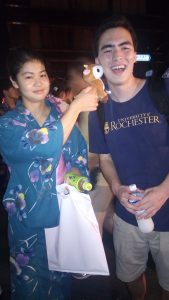
I have also seen an overall increase in my fluidity. There’s no better feeling than when you hammer out a sentence with a complex (for me at least) grammar structure with understandable pronunciation and only a few pauses. Okay, maybe “no better feeling” is a bit of an exaggeration, but you get the point. Writing and reading are great, but I learned Japanese so I could speak the it, and I feel like this summer has really allowed me to do that.
I described my most challenging linguistic experience a few weeks back when talking about my experience at that restaurant, so I’ll just discuss my biggest frustration with practicing Japanese since coming to lab. Because my lab is international, the primary language is English. This means that, for the most part, people speak to me in English and I speak back to them in English. Even with the native Japanese speakers in lab, work tends to be delicate and time-sensitive enough that I feel like I can’t take the time to form my sentences in Japanese. As an example, I was watching some people using the PPMS, and I noticed that they were doing other things while the system was flooding. While I could have tried to tell them in Japanese, it was much safer and pragmatic to just tell them in English that they should probably purge the system. Of course, I can’t expect to be practicing my Japanese all the time, and lab isn’t exactly the best place to be doing it. Overall, it’s actually a very minor issue, but certainly noticeable enough to be annoying at times. It’s a little strange to half-wish that my primary language wasn’t spoken as much in my lab; I know my current lab situation probably carries more pros than cons for me.
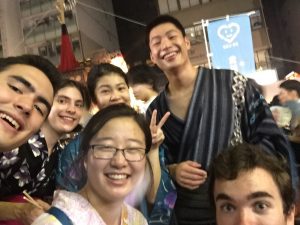
All of that said, I practice Japanese as much as I can with the Japanese lab members. I try to start conversations during lunch and when people are sitting in the office clearly not doing anything. I also try to listen in on Japanese conversations and try to understand them, which, thinking about it now, seems a little strange and intrusive. There’s also a language class that I’ve been trying to attend, but due to the Mid-Program Meeting and some poor timing of experiments, I actually haven’t been able to attend in about a month, which is a shame.
I think speaking is the best way to learn for me now, which I think I’ve said before. Now that I have the knowledge of basic grammar structures and vocabulary, the best way to improve is to gain the ability to put that knowledge into use.
I thought that, after two years of studying Japanese at my university, I was done with taking Japanese classes, especially due to the increasing difficulty of classes and such. However, after this experience, I am seriously looking into taking some conversational classes in Japanese starting next semester. If nothing else, I plan on making my Japanese friends have conversations with me in Japanese instead of English. Whether they like it or not.
Question of the Week
Festival-themed question in honor of the Gion Festival going on this weekend. Someone at the festival asked (I can’t remember who) if all of the food stands were just local businesses who came out to run stands. Maybe not a cultural question, per se, but I’d like to know the logistics of food stands. Who can make a stand, how do they reserve a space? Food stands selling the same food always seem to be spread out, so does the city plan everything?
Research Project Update
With what few single crystals I could find on my first attempt crystal, I was able to run XRD and magnetic susceptibility measurements. The XRD had only the characteristic peaks of a Bi-2212 single crystal, and the peaks were sharp, suggesting good crystallinity. The magnetic susceptibility measurement showed a critical temperature of about 97K, which is really high, and seems to fit with the rest of the points my mentor’s already gathered, which is good. Hopefully this means the powder I prepared is of good quality.
Unfortunately, that’s about all I could get from that single crystal. The rest of the pieces were too small to be used for anything useful. Starting this past Friday, I began the preparation of another single crystal from the same powder as before. The alignment looks better this time, so hopefully the crystal will turn out much better and I’ll be able to do proper analysis on it. The ARPES will hopefully also be up around the same time that crystal finishes in 2 weeks. Ideally, I’ll get to use it as soon as my second crystal is ready.
Week 10: Interview with Japanese Researcher
Just a note, I decided to conduct this interview in Japanese so I could practice, so I apologize for any mistakes caused by my terribly lack of Japanese speaking and listening skills.

I interviewed Nishino-san from my lab. He got his Ph.D. and Master’s in Material Science (MS) from the Japanese Institute of Science and Technology (JAIST, because I don’t want to type this again) after studying Engineering at Ibaraki Kougyou Koutousenmongaku as an undergraduate. He is now a post-doc at my lab.
In elementary school, Nishino-san received an opportunity to enter a program focused on addressing the energy crisis and environmental issues in general. This program caused him to become very interested in working to resolve the energy crisis. This is why he decided to study engineering as an undergraduate student.
However, after finishing his undergraduate, Nishino-san wanted to move away from his house, so he decided to do his Master’s and Ph.D. at JAIST. “Not very deep,” Nishino-san had to say about this decision.
Nishino-san said that college was fun for him, and that he thinks that most other college students in Japan feel the same way. Sarah said that college in Japan is much more relaxed compared to high school. I suppose this response reflects this. It’s the complete opposite in America, though. “But classwork is difficult,” Nishino-san said. I guess that’s true everywhere.
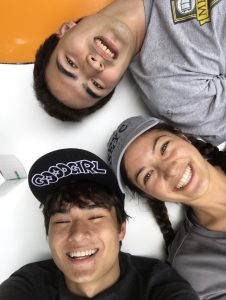
Nishino-san isn’t really sure what he wants to do after finishing his post-doc. All he knows is that he is still interested in the energy crisis and wants to continue doing research. Eventually, he may want to become a professor, as well. This was actually a very inspiring response to me. Instead of being focused on moving to a particular location or making a lot of money, he just wants to continue to do what he loves: advance science. I’m learning more and more that that is the attitude you need to succeed in this career. If you don’t truly love what you do, you’ll eventually be beaten out by those who do.
Outside of Japan, Nishino-san has been to America and Germany, but only to attend conferences. He makes it clear that he doesn’t know for sure, but his impression is that American labs are much richer than Japanese labs. This came as a surprise to me, as Kyoto Daigaku and Tokyo Daigaku both had such amazing laboratory equipment (as does my lab), but perhaps my sample is very skewed towards the richer end of the scale. Nishino-san noted that, before coming to this lab, he often had to build and program his own measurement-taking equipment. He appreciates this experience now, as he’s been able to use the knowledge he gained in doing this, but having the equipment on hand is obviously very nice and accelerates the research itself.
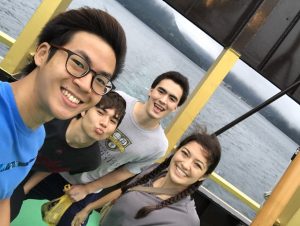
Our lab is very international; half of the people working here are from outside the country. Nishino-san said that having an international lab is nice, because he is able to communicate frequently with everyone. Apparently, he could not speak English at all when he first arrived at lab, but learned because the primary language here is English. This was astounding to me; his English is very good. That said, Nishino-san does get frustrated at times, because he often cannot communicate the message he needs to in English with the required specificity needed. He used operating machinery as an example. Most of the manuals here are in Japanese, so Japanese members of the lab have to explain to the non-Japanese members how to operate things. Of course, doing something even slightly wrong can have disastrous results in lab, and Nishino-san finds it difficult to communicate exactly what needs to be done in English. It’s funny, I talked in last week’s report about a similar struggle I’ve been having, just with the languages reversed.
Nishino-san will go to Pasadena in two weeks for a conference. He asked me for food recommendations. Unfortunately, as someone who’s spent his entire life in the northeast, I have no idea about Californian cuisine. Japanese food is much better than American food, in general (in my opinion), so I wasn’t sure what to recommend from American cuisine as a whole, either. Steak?
Nishino-san was also curious about what my plans are for after my graduation. Excellent question. I am still switching back-and-forth between wanting to go to graduate school and eventually becoming a professor, and just going straight into industry. I still have a lot of time, but it’s something I definitely need to put more thought into.
Question of the Week
I noticed this while in Tokyo, but it never struck me as that strange for some reason (until now), and I never bothered to ask (until now). Japanese children seem to be very independent; I often see kids who can’t be any older than 10 or 11 riding the subway or even walking at night all alone. In America, this would be seen as very strange and dangerous. I know that Japan is safer than America (I feel much safer walking alone at night, too), but I feel like parents are overprotective no matter where you go, so it seems strange to me. Maybe this is a function of me living in the suburbs my whole life, and it’s actually just a city thing. But, I’m still curious as to why children are able to move about so freely on their own, even at such a young age.
- There is a proverb in Japan, “Send the beloved child on a journey”. This highlights how Japan sees one of the roles of parenting as being developing a sense of independence in their young children. How we raise children is also a reflection of our cultural and societal values and in Japan the emphasis on the well-being of the group means there is greater trust that society members will watch out for and help keep young kids walking on their own safe. Structurally, the fact that most children can use the subway or extensive bus networks to travel to/from school and that overall Japan has more pedestrian friendly cities means that it is safer for children to walk along the sidewalk/streets without as much fear of them being hit by a car.
- In the U.S., we have transitioned from a similar sense in the 1970s and 1980s (where my parents would send me outside to play and tell me not come back until dinnertime – with no idea where I was going or what I was doing – to the reality of today’s helicopter parents and hyper scheduled lives of young children who must check in (sometimes on the hour) with parents via phone or text.
- You can read more about this on the Education in Japan section of our Life in Japan page. See the articles listed under Independence of Children in Japan section for insights into how Japanese parents and schools help train children (and parents) to let go and allow children to gain independence by walking to/from school on their own at a very young age.
Research Project Update
Finally getting some good data! My second single crystal is growing pretty straight this time, and looks fairly stable (but you never know). I’ve taken resistivity, Seebeck coefficient, and magnetic susceptibility measurements of my first single crystal. These measurements show a very high critical temperature (onset of ~105 K, downset of ~98 K), meaning my sample is optimally doped. I’ve also taken a phi scan XRD which shows that the crystallinity is very good (4 peaks separated by 90 deg, as predicted for a rectangular structure).
If nothing else, I’ll be able to report this data at the end of the summer, which is a comfort. But, the main point of my research is to get the energy-momentum dispersion graphs with ARPES. The ARPES will be up in about a week (hopefully), so I continue to eagerly anticipate it being ready.
The plan for the near future is to orient my crystal to prepare it for ARPES measurement.
Return to Top
Week 11: Critical Incident Analysis – In the Lab
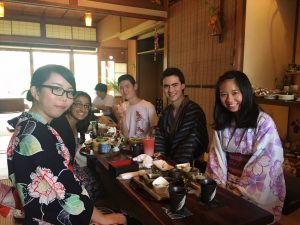
Magically, as if to tie together my past two weekly reports together with a nice little bow, I had a pretty frustrating experience in lab this week. I had to use a machine (Laue x-ray diffraction) for the first time, so even after being taught briefly I didn’t really know exactly what I was doing. My professor and mentor were out of lab, so I was consulting another member of the lab, who knew how to use the machine.
I wanted to switch out the collimator for the x-ray, but wasn’t sure how to do it, so I tried asking this other lab member. However, I didn’t know the Japanese word for collimator, and he didn’t know the English word, so I spent a few minutes trying to explain it to him, but failing because my Japanese wasn’t good enough. It didn’t help that the manual for the machine had mysteriously gone missing right as I started using it and that the machine is 40ish years old.
I ended up finding the collimator and was able to gesture towards it to try to explain what I wanted to do. He knew what I was talking about now, but I still wasn’t sure if he knew what I wanted to do. I wanted to make sure he knew so he wouldn’t inadvertently do something that would alter my experiment, but I wasn’t sure how. He started to help, and he probably knew what was going on, but he was clearly a little uncertain as well and what he was doing involved taking apart the machine a little. I didn’t want to take any risks, so I ended up stopping him, telling him it was okay, and decided to wait for my mentor and professor to get back to lab (which, luckily, happened in just an hour or so).
Tying this back to my week 9 report, this experience was frustrating for me because I didn’t have the proper knowledge of Japanese language to properly convey my thoughts. From my week 10 report, coming at this from the other side, this experience was probably frustrating for my lab mate because he didn’t understand me and couldn’t properly convey his thoughts, either. We both had a clear image of what we wanted to say in our minds, but that was lost somehow in the language.
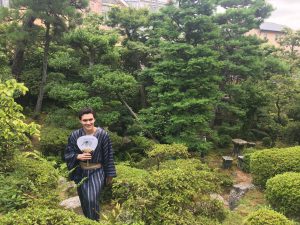
I feel like this is something that happens more than we realize, even when both people are speaking in the same, native language. The assumption is too often that every sentence, gesture, inflection, etc. means the same thing to the listener as it does to the speaker, but that is clearly not the case. Everyone brings their own background into every conversation they have, and this affects how they speak and how they view the words spoken to them.
Of course, in your average conversation about how horrible today’s breakfast at the cafeteria is, these differences don’t make much of a difference. But, I think we must be careful in discussions regarding moral, ethical, emotional, and other similar types of dilemma. If we always judge people’s thoughts based on their words (or even actions), and apply those words to our own internal standard of what those words mean, all we’ve done is add a degree of separation which allows for misunderstandings to occur. Not to mention the degree of separation that occurs when the speaker has to translate their thoughts to words. The speaker is limited both by themselves (they generate their words based on their internal standard) and the vagueness of language (for example, we use “happy” to refer to a large range of emotions). The listener is limited through similar effects. Both people thinking they understand the other when they really don’t; that is a really dangerous thing.
This is has been a great frustration of mine for about a year now; how am I supposed to communicate my thoughts and feelings to someone such that they can truly understand them, and; how am I supposed to understand someone else’s thoughts and feelings, truly? Of course, stopping to define terms is always helpful, but this is time-consuming, and an incomplete solution (language has its limits). Getting close to someone and learning more about them over time is also helpful, but those degrees of separation still persist. I’d imagine, if true understanding exists, the method of transfer of information from one person to another doesn’t involve language at all. It may be a fool’s dream, to search for such a thing as true understanding (whatever that even means), but that’ll never stop me from trying.
This got unexpectedly philosophical, and maybe a little dense for a casual read, but hopefully it was a good change of pace. Applying these ideas to the actual topic at hand, I think my experience this week was frustrating to me, especially, because it was, in some ways, just an obvious manifestation of my past frustrations. I think the solution, in this case, would have been for me to just be more patient. If I had taken more time to explain what I wanted to do, and tried a little harder to understand what he wanted to say, perhaps the problem could have been resolved between the two of us. Science has the advantage of having its terms relatively well-defined. At the very least, this was an experience to take note of. Next time something similar happens, I’ll try to be more conscious of what’s happening and what I can do to help resolve the issue.
Also, I don’t have any good photos of me there, but I went to the RoboCup this weekend! Lots of cool inventions, including an exoskeleton, lots of robots that play soccer (they had a tournament), and robots that put cans in the trash for you (I could use one of those…). Went with Shivani, Trevor, and Katelyn. Was a blast!
Question of the Week

Tomoyuki (a Japanese Nakatani Fellow) told me that one of the biggest problems with Japanese culture was that they “look inside,” meaning they only want to talk with people in their “in-group.” This causes them to not want to talk to people from different countries or even people from different areas in Japan. He explained Japanese politeness as being partly influenced by the fear of being excluded from the in-group. I can see where this attitude would come from, as Japan had closed itself off from foreign influence in the past. I could also see influences from feudal Japan.
That said, it’s been almost 50 years since the Meiji Restoration, even longer since the end of feudalism, and, looking around, there seem to be foreigners everywhere. So, my first question is, why does this attitude still persist even though most Japanese people seem to have a lot of exposure to foreigners and people from different regions?
This statement was also contradictory to my experiences in Japan. I’ve had, for the most part, nothing but positive experiences with Japanese people. They are always polite and go out of their way to help you. The Japanese people I’ve met personally have also been very kind to me and haven’t seemed to exclude me in any way due to me not being in the in-group. So, I’m also wondering where I can see this attitude manifesting itself in Japan? Is it disappearing?
- See Uchi-Soto and Group Culture in Japan on our Life in Japan Resources Page
Research Project Update
Took out my new single crystal, but it was even worse than the last one in terms of the size of the pieces. I’ve run resistivity, Seebeck coefficient, and magnetic susceptibility measurements on it, and it looks like the critical temperature is significantly smaller (~93 K as opposed to 97 K). This suggests the composition of the two samples is different, which is strange, considering they were made from the same powder.
Off the top of my head, it’s possible this means I didn’t mix the original reagents well enough, which is weird because I mixed it quite a bit and my mentor said it was fine. The only other thing I can think of, though, are edge effects causing certain areas to form different compositions (perhaps some lead was lost from the powder on top, due to its relatively low volatility), but this also seems strange, and I’m not sure of the mechanism by which this would occur. Additionally, because the powder was mixed before being put in the floating zone furnace, this shouldn’t make any difference unless the changes occurred in the furnace itself. But, the same conditions were used for both single crystal growths, and the crystal structure isn’t supposed to change much in the furnace, so, again, this doesn’t make much sense. Maybe, because the crystal was melted during growth, certain compositions solidified first, in which case the location along my crystal that I got my sample would matter. But, the different compositions shouldn’t be that different, so that also seems unlikely. I guess I don’t really know enough about solid state physics to say anything with confidence.
The data for the new crystal isn’t as good, so I’m probably going to stick with my original crystal. We aligned it via Laue x-ray diffraction (which is where my critical incident occurred).
My first sample for ARPES failed due to poor electrical contact. We’ll be trying again next week. This sample is my last chance to get ARPES data, so fingers crossed.
Week 12: Final Week at Research Lab
I think that, in the past, I saw Japan as just another vacation spot. It was a place with lots of cool things to see, a new culture to experience, and just a welcome break from the cold of Rochester. Staying here for an extended period of time has changed that attitude a lot. When you’re on vacation, it’s easy to forget sometimes that, for some people, the culture you’re experiencing, the sights you’re seeing, they’re all an ordinary part of life. This place feels like a second home now, because I know what it’s like to actually live here and be a part of the culture. I understand much more about the ins-and-outs of daily life here than I ever could have gotten staying here for a week at a time.
Along the same vein, I realized that I’ve been taking America for granted. It’s easy to forget when you’re surrounded by all of these new things, but after settling down and getting into a daily rhythm, you start to miss those basic pleasures: being in a place where the vast majority of people speak your language, being able to be (almost) as loud as you want and not bothering people, etc..
I could fill a book with the things that have changed about me since coming to Japan. This experience really allowed me to get in better touch with myself. I discovered countless things about myself: things I like, things I want to change, and things I don’t quite understand yet. All of this coming at a time when I thought I was just starting to figure it all out, it was a surprise to me. Life is never-ending journey of growth, I suppose.
Maybe I should be less vague. I’d say from the things I’m willing to put here, the most notable is a willingness to try new things. Japan was, in a lot of ways, just a barrage of uncomfortable experiences, from trying to have conversations in Japanese, to eating a lot of strange foods, to entering the onsen. What I discovered was that, most of the time, when I stepped out of my comfort zone, I was rewarded for it. I improved my Japanese, ate some delicious meals, and got to have some deep conversations in the onsen. But even those times when things didn’t turn out too well, I was always able to learn something and grow from the experience. There’s a world full of lessons outside of my comfort zone, I just have to go outside and find them. That’s not to say I’m going to go shark wrestling or something any time soon, though….
Without a doubt, the most frustrating reoccurring experience for me was being treated like a foreigner when I’m spending my time here, in large part, to be immersed in the culture. It’s little things, like being given an English menu when I don’t ask for it, being answered in English despite asking the question in Japanese, or being told to go to the English Information Center when I purposely came to the regular one to practice Japanese. And all of these things, on the surface level, are just people trying to be polite, helpful, and accommodating. But, they remind me that I’m a foreigner, and that everyone knows it. Worse, they always leave that (culture) gap between me and full immersion in Japanese culture. Just another thing I took for granted in America, I suppose. I don’t blend in here, and that’s something I have to deal with.
The thing I will miss the most about Japan would probably have to be the konbini’s, and everything they represent about Japan. The cleanliness, the close proximity, the good food, the convenience, the variety, the politeness, they’re all things you would be hard pressed to find in my part of America, where the nearest restaurant is 10 minutes away by car.
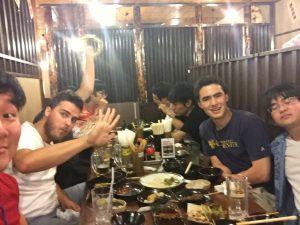
I’ve “worked” in research labs before, but it wasn’t until this experience that I realized that “worked” belongs in quotes there. It’s one thing to stop by lab for a couple hours between classes, a whole different thing to wake up, go to lab, stay there for 10+ hours, and go home. This was the real deal. I realized that if I want to succeed in the academic world, I have to find something I’m so passionate about that I can live this way day in and day out for a lot longer than 10 weeks, and still find the energy to press forward. It’s really amazing watching people when they talk about their research; their eyes light up so brightly. I wouldn’t say my career goals have changed, I’m still working towards professorship, but I now know better than ever that what’s needed to succeed is far more than a few good grades.
My last week at lab was a scramble to finish my posters and presentations, and to pack. Very little experimentation was done, but it was still a pretty stressful week. I am writing a paper for Professor Takeuchi, and will stay in contact with both him and my mentor regarding the project. I am unsure whether this will turn into anything more than that, however. I am also attempting to get into the Gulf Coast Undergraduate Research Symposium this November 4th, which means I will be staying in contact with them to prepare my abstract and presentation.
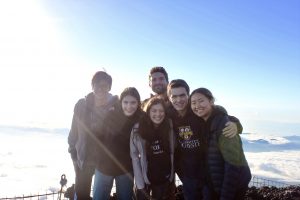
My last weekend in Japan, Savannah, Kaylene, Rose, Josh, and I climbed Mt. Fuji. It was simultaneously one of the greatest and most horrible things I’ve ever done. We started our climb around 8:30 pm, and arrived at the top around 4:30 am (although I don’t remember too well, to be honest). It started off pretty well. We took frequent breaks, and everyone was in high spirits, for the most part. However, near the top, the thinning of the air became painfully clear, and we began to have difficulty holding conversation. As we merged with other trails, the road became more quiet and solemn, as people marched upwards, hoping to get a glimpse of the sunrise at the top. As sunrise drew closer, we put in the last of our energy to run to the summit, pushing past the people resting on the rocks who had already given up on making it in time. Just as we made it to the pile of dirt where everyone was eagerly waiting the sun, we saw the first glimpses of it. And wow was it incredible. Neither pictures nor words can describe the feeling of being rewarded with such beauty after pushing yourself to your limit. I leave it to the reader to experience it themselves, if they are ready and willing.
The climb down was even more taxing. Already exhausted, tired, and oxygen-deprived, we were hoping for a quick run down the mountain to return to civilization and sleep (we had to pull an all-nighter to make it for sunrise). What we got instead was a long walk down a grueling path. Most notably, there was this sand path with deep sand that got up your shoes and just enough large rocks to keep you from sliding down. This path lasted for about 2 hours, and was only a portion of the total thing. I honestly thought we weren’t going to make it for a little while. I still can’t look at sand without being traumatized. But, eventually, we made it to the bottom, took the bus back, and life returned to normal.
I think this climb describes a lot of the hardships we face as people. We find something we want to do no matter what (to see the sunrise on top of Mt. Fuji), and resolve ourselves to do it. We prepare ourselves (rent out equipment), and make a plan. Then, we begin. So many people want to achieve the same thing we want to; it is on the journey that our preparedness and resolve is really tested. Most give up before they try, telling themselves they can’t do it. Many give up just as they begin, thinking it’s not worth the struggle. Some make it so close, but can’t seem to find that last burst of energy needed. Only a few, after many, perhaps countless, hours of effort, actually make it. Maybe, for a few, it was no big deal. But after all is said and done, we pack it up and look for the next goal, whether that’s climbing to even higher heights or doing something completely different. And, of course, it’s easier and more enjoyable with friends.
In a lot of ways, this describes our journey as students. We find that goal, of professorship, of industry, etc., and enter higher level academics to try to reach it. Then, the journey of countless classes and tests and opportunities begins. Some drop out right at the start. Some realize halfway through they want to pursue something else, and change their goal to something new. Only a few actually make it. And it’s that journey that makes the view at the top so much more spectacular, because you’ve accomplished something only a few could do, something that caused doubt in your mind that you were able to push through, something that you wanted so badly.
I hope that I can reach my personal summit, whose mountain I am currently climbing: professorship. Perhaps I will decide that I want something different, and find a different mountain altogether to climb, who knows. But I know that when I reach whatever summit I am aiming for in this academic journey of mine, it won’t be the end. The strength I will have gained in this climb will become new possibilities for me to climb to even greater heights. I will always have something higher to reach for.
The same could be said for this program. It was the because of, not in spite of, all of the trouble I had that my research felt so worthwhile in the end. I did some really unbelievable things here, and it’s hard to believe that I’m now back home where it all began. But, I will use this experience, and all of my previous experiences as well, to find new goals, new heights. This is only the beginning.
Week 13: Final Report
Stepping off the plane and back into America felt unreal. For lack of a better phrase, I felt dazed. All of a sudden, the signs were in English, I could understand the conversations around me, there were actually water fountains but drinks from vending machines were $3 a bottle, and everything which had just been a natural part of my life just two days ago felt so far away. It truly felt like the end of a major chapter in my life, and I didn’t know what to feel. In all honesty, I still feel that way to a degree. I suppose I was lucky to have people around me who were going through the same thing and to whom I could talk with about it.
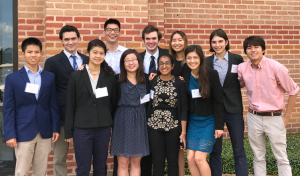
The re-entry program went by in a flash. We were quickly reminded that an important life decision was fast approaching: graduate school. I learned a lot of new information about graduate school: what I need to do in preparation, where to look, how to apply, opinions on what makes a good graduate school, and some other helpful information. It was a lot of stuff I had never known and never bothered to look into, but which I absolutely should have. This program was very good in that it gave me a lot of the information and resources I will need to make an informed decision about which graduate school to go to. We also got tips on our resumes, which was very helpful for cleaning it up and adding this program to it.
Of course, we also had to prepare for our poster presentation. We got to practice talking to people with different levels of knowledge about our topic, and learned how to adapt to changing circumstances. I actually found myself remembering and actively applying the things I learned during this session in the actual poster presentation, so it helped out a lot.
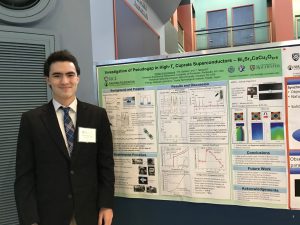
Presenting my poster was really fun. After working the past couple months on my project, I found myself wanting to tell people about it and have intellectual conversations regarding it. Unfortunately, I was tucked away in a dark corner of the room, so I didn’t get many visitors, but when I did get the chance to talk about my research, people seemed to want to stay around to listen and ask questions, which felt good. It was really nice to have an excuse to talk about my research and to have my work recognized.
The whole focus of my research was a very specific trait of certain types of superconductors, so I spent a lot of time explaining background knowledge. This was fine, because I could do it relatively quickly, but when people showed up after that explanation, it was hard to catch them up because my results don’t make much sense without the background. This was the hardest part of presenting for me: bringing people into the middle of a conversation. Luckily, the “main point” of each set of data was understandable, so it was possible to explain at least the results to others without the introduction. After explaining the conclusion, most people who joined halfway through seemed to be interested enough to inquire about the background, which was good.
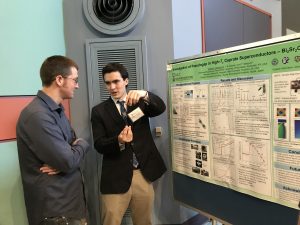
I think, the next time I present a poster, I want to try harder to actively bring people to my poster. Reaching out to people who are looking from afar, and having more positive posture and hand gestures are two things I want to try.
The most rewarding moment of the presentation was when I was talking to one of the judges. It turned out that he studies the same phenomenon I was studying, and so we were able to have a real intellectual conversation about it from the get-go, with no explanation of terms necessary. He also told me about his research. At one point, I was able realize a connection between a small thing he noted earlier in the conversation and a problem later. When he told me, “that’s right,” I felt like I had proved to myself that I was actually becoming proficient in the topic, despite having no background knowledge beforehand. What’s more, it showed that I could think critically and communicate with an expert. It was the first time I could see my progress towards that goal I’ve had for the longest time of being a professor.
I’ve talked a lot already about what I’ve gained from this program, at least in regards to experience. To an employer, these things may be the most important thing. I’ve learned how to operate high-tech equipment, worked in a lab full-time doing independent research, presented my work at multiple presentations and a colloquium, collaborated within an international lab, learned more than I ever thought I would know about solid state physics, experienced a different culture first-hand for an extended period of time, and much more. These things are certainly the easiest things to talk about, and perhaps the most tangible things I have gained.
But these experiences, while certainly some of the most valuable, are only surface level. Anyone reading my resume or the Nakatani RIES website wouldn’t need me to tell them that I’ve done these things. What I really want to tell people about aren’t the things I did in this program, but the ways that this program changed me. The Nakatani RIES program allowed me develop a new passion for research, a better appreciation for other cultures, an enhanced awareness of those around me, new interests gained from my conversations with others, confidence in myself and my abilities, and so much more. Because of the things I’ve experienced on this program, returning home, I’m going to become more proactive in meeting people and making friendships, try to start playing piano more again, pick up an engineering club at my home university, etc.. While my plans to attend graduate school haven’t changed, those plans are now far more informed, both in that I know much better what that plan really means, and in that I know much better how I would carry it out. Of course, nothing’s set in stone yet, though.
Final Research Project Overview
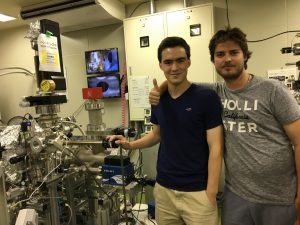
Title: “Investigation of Pseudogap in High-Tc Cuprate Superconductors – Bi2Sr2CaCu2O8+δ” (PDF)
Host Lab: Toyota Technological Institute Energy Materials Lab
Host Professor: Professor Tsunehiro Takeuchi
Mentor: Dr. Robert Sobota
Introduction: Cuprate superconductors have a high critical temperature (Tc), notably above liquid nitrogen temperature (73 K). This makes them ideal for cheap application in numerous fields, including transportation, medicine, research, and energy. However, a pseudogap, which competes with the superconducting state, and therefore decreases the Tc, has been discovered in these superconductors. If the pseudogap could be suppressed, it may allow even higher Tc values, broadening the practicality and application of these superconductors further.
Approach: The goal of this research project was to create a high quality single crystal sample of optimally Bi2Sr2CaCu2O8+δ (Bi2212), a high Tc cuprate superconductor, usable for ARPES analysis. This was achieved with repeated heatings and the Traveling Solvent Floating Zone (TSFZ) method. The purity and crystallinity of the sample were confirmed with XRD. The sample had its transport and thermodynamic properties (electrical resistance, Seebeck coefficient, and magnetic susceptibility) measured over a temperature range from 5 to 300 K to confirm optimally doped conditions. Then, ARPES analysis was performed to investigate the energy-momentum dispersion of electrons near the Fermi energy, where the pseudogap and superconducting gap are, in hopes of improving the understanding the pseudogap and superconducting gap in cuprate superconductors.
Results: XRD and PPMS measurements show that a high quality single crystal sample of Bi2212 was created, and that that sample was optimally doped with a high Tc of 97 K, respectively. However, ARPES measurements were unable to observe a dispersion pattern on the 2D Fermi surface.
Conclusion: Based on the results, it appears as though a high quality single crystal sample of Bi2212 in the optimally doped regime was successfully obtained. It was also successfully aligned via Laue Diffraction. However, a dispersion pattern could not be identified, for an unknown reason. Because the desired product was created, and strong signal was obtained during measurement, the reason for this is unknown.
Future Research: Future research should involve investigating the current sample to locate the dispersion pattern or discover why none was observed. Additionally, samples with different doping conditions should be prepared so that the pseudogap and superconducting gap may be examined as a function of doping condition, temperature, and angle on the Fermi surface.
Final Remarks: It was a lot of work, and a little disappointing that it didn’t all come together at the end, but I had a lot of fun and learned a lot. Thank you to everyone, in lab and out, who helped me out during this experience.
Follow-on Project
I want to talk with the University of Rochester’s Center for Education Abroad about holding an information session and/or sending information via newsletter or other media outlets. I also want to discuss with the major engineering organizations on campus about doing similar things. I may also talk with my high school about holding a presentation, because I wish I had thought more seriously about going abroad before attending college, and it’s never too early to get started.
Tips for Future Participants
Pre-Departure
- Don’t over pack. Better safe than sorry, but most of the things you will need for daily life will be available in Japan, too. If you’re unsure, look into it.
- You will most likely have access to laundry very close to you, so a week to two-week supply of clothes is plenty. I did laundry every Friday night, and didn’t even end up using all the clothes I packed.
- It’s a struggle to carry around 2 heavy suitcases, and you don’t want to have to sacrifice a souvenir to make room for something you didn’t even end up using. Bring an empty duffel bag in your suitcase to carry back souvenirs.
- Read up on your research topic: “Before I left for Japan I wish I had researched a little more about my research topic. You learn a lot on the job, and I was just fine with very little preparation, but just a few keyword searches on Google Scholar or something, I feel, would have made a world of difference. And trust me, the last thing in the world you’ll want to do during orientation is read a solid state physics textbook. I know classes are coming to a close and there’s a lot to be done, but find time; it doesn’t need to be much.”
Orientation Program in Tokyo
- Listen to the seminar speakers. They have a lot of cool cultural perspectives on Japan and you will learn a lot of the dos and don’ts of Japan that won’t make it on any of these tips. I can’t count the number of times something one of the science lecturers said ended up being useful in my research; they pick these speakers for a reason.
- Get to know all of your fellow Nakatani Fellows. The people on this program ended up becoming some of my closest friends in the world, and the same will probably be true for you. You get a lot of free time to hang out with them during orientation, so use it to get to know each and every one of them; they’re all incredible people with unique backgrounds and interests, and thought-provoking views on the world, I promise. You have so much to learn from them.
Mid-Program Meeting in Kyoto
- This is your time to get refocused on research, talk to Prof. Kono, Sarah, Ogawa-san, or the other experts about how your research is going and where you should go from here. Definitely don’t be scared to voice any concerns; they’re there to help.
- That said, this is also your chance to finally relax and get away, so don’t get too preoccupied with research. Spend time with the other Fellows, relax, take a dip in the onsen, explore the city. I suggest you use this time to reenergize yourself and prepare for the coming weeks of research.
Working with Your Research Lab
- “While I was in Japan I wish I had interacted with my lab more. I really only became close to my lab mates in the last few weeks in lab. But they were all such great people, I really wish I had more time to get to know them. It can be tough, especially if you’re typically a quiet person, like me, and Japanese people don’t typically make the first move, but make the effort; it can make your time in lab tremendously more enjoyable.”
- Take the initiative and get to know your lab: Ask your labmates if they have plans after lab, maybe offer your help with routine tasks (taking out the trash, cleaning up, etc.), and overall just take the initiative to start conversations. Most of them are probably really nice and want to talk to you, too. And if they do invite you somewhere, say yes!
- If you’re invited somewhere, just say yes!
Living in Nagoya
- There isn’t much to do really close to TTI. There are a few restaurants that are pretty good and a pair of konbini about a 7-minute walk from the international student dorm (TI House). These places are pretty convenient and right next to the station, too, so I found myself going there nearly every day.
- There is a EqVo, which has all your basic toiletries, stationary, notebooks, bags, a grocery store, etc. for cheap. I’m sure someone will point it out to you. It’s about a 7-minute walk from TI House.
- If you keep walking along that road, there’s this neat little place called Hill’s Walk, which is basically a mall with a bookstore, clothing, and a food court. Hill’s Walk is about a half hour walk away, and I really enjoyed walking there at least a couple times every week.
- But, if you’re not into that kind of thing, you can also take the subway 2 stops to Tokushige, which connects directly to the place. If you walk just a little bit further, there’s a peaceful river which is great to walk along.
- There’s more, but those are the basics. Basically, there’s a lot to see, if you’re willing to go out and look for it; I suggest you do!
- Of course, don’t neglect the rest of Nagoya. You have the zoo, sky tower, aquarium, port, a bunch of neat temples, Aeon (off of Aratama Bashi station), central park, Oasis 21, etc.. I wish I had taken the subway more and just looked around.
- Hitsumabushi and tenmushi are Nagoya’s signature dishes. Try them out!
- Explore! People will tell you there’s nothing to do in Nagoya, but just like any city, there’s plenty to see, if you’re willing to go out and look for it.
Language Study Tips
- Learn your hiragana and katakana, and, if you’re feeling bold, download a kanji study app. They’ll be very useful to you for getting around Japan.
- Speak as much as possible! Don’t be afraid to drop a “sumimasen” and ask someone for help; you’re less likely to get lost and it’s a great way to practice!
Other Tips:
- Drink lots of calpis (and bring me back any limited-time flavors).
- Try curry ramen. I had no idea it existed until my lab mates showed me. It’s pretty good.
- Spend weekends visiting other U.S. (and Japanese) Fellows (they can show you all of the best places around).
- Visit Hakone.
- See the lantern festival in Odaiba, if possible.
- Sendai is actually a really nice area, if you can get up there.
- Get a funny English shirt, they’re everywhere and I really wish I had gotten one.
